Send us an email

15 ways to use social media for education
Written by by Jamia Kenan
Published on September 6, 2023
Reading time 9 minutes
With remote learning and emerging technologies like artificial intelligence (AI), social media is an integral part of education more than ever. There are many different ways to use social media for education inside and outside the classroom.
Because we believe in the power of social media to make nearly anything easier, we will share 15 ways to use social media for education, based on insights shared with us from top institutions.
Benefits of social media in education
Here are our top three benefits of using social media in education:
Benefit 1: Extends learning opportunities
Social media unleashes more learning opportunities. Online classes and remote jobs are the new norm, so teaching students to work from a distance becomes a necessity for digital literacy and preparing them for their careers. Social media platforms support educators in various ways from sharing announcements to holding live lectures.
Benefit 2: Create connections with students and alumni
Social provides a way for institutions to quickly and directly communicate with students, faculty, staff and alumni, fostering connections across various audiences. Social content can attract prospective students, keep parents informed, grow alumni networks, promote on-campus events and more.
Focusing on nurturing community and publishing engaging content can also help increase enrollment. According to our Higher Education Social Media Benchmarks for 2023 report, 41% of school officials can directly attribute increased enrollment to social strategy.
For example, Keele University said their campus photos on Instagram help students solidify their college decision. One student came to the university because she saw their posts on Facebook and it helped confirm her decision, later becoming a digital ambassador for the school.

Benefit 3: Build brand identity
Social supports and amplifies university branding . University marketing teams use social media to maintain a positive brand reputation for their institutions. With the right strategy, colleges and universities can attract more students, increase endowments, promote events or initiatives and improve alumni relations.
Social media in the classroom
From preschool to college, there are so many methods for using social media in the classroom to communicate and educate. Here are seven ways to use social media in the classroom across platforms:
1. Use posts to broadcast updates and alerts
Instructors and colleges can meet students where they are by incorporating social media platforms they’re likely already familiar with like Facebook or X (formerly known as Twitter).
Have students follow a class Facebook Page or join a Facebook Group to view posts about course updates, homework assignments and tests. Universities can have publicly accessible pages dedicated to specific schools or departments that students can see even if they aren’t active on Facebook.

When using social media for education, it’s important to maintain a professional boundary. Email students a direct link to the Facebook Group for access and avoid sending friend requests. Groups are the perfect “home base,” especially for online courses because it makes it easy to connect with students. Similarly, instructors and departments can use Posts on X to keep students informed.
2. Use live streaming for lectures and discussions
Instructors can use Facebook Groups, Instagram Live, YouTube Live or LinkedIn Live to stream lectures and facilitate more accessible learning. If a student can’t come to the lecture hall, they can join online or review later. Adding live captions helps students who may be deaf or hard of hearing, non-native speakers, or learn visually. And platforms like Instagram and YouTube allow live streams to be recorded, providing students with review material for midterms and finals season.
Recorded live streams also widen the institution’s reach and authority by making lectures available to scholars and professors from other colleges, states or countries.
3. Use X for class updates and more
X is a great option for providing quick updates and reminders to students. Teachers can create a single handle per class and reuse it every year, or they can create a new handle each school year. Use X threads to share resources like practice quizzes, interesting perspectives or thought-provoking quotes to foster critical thinking. Hashtags can mark specific discussions or chats with guest speakers.
4. Create a class blog for discussions and cross-channel learning
Blogs are another great outlet for incorporating social media in the classroom. Students can link to the class blog on other social channels. For example, a student might share a photo from their visual essay on LinkedIn to attract the attention of recruiters for job or internships. Using blogs as a semester-long assignment can improve students’ short-form writing and critical thinking.
Don’t feel limited to just an English or writing class; this use of social media in education can be transferred across all subjects. There are also several platforms professors can use to create class blogs, such as Tumblr, Medium or WordPress. The course syllabus, updates and resources can be shared on the blog as well.
5. Use Instagram for digital storytelling
Have students practice storytelling on Instagram by creating class-specific accounts where they can present photos or graphics (and delete them once the course is over, if they so choose). This can work especially well in visual-heavy classes: Have photojournalism students post essays or challenge the social media marketing class to create a faux-brand campaign.

6. Create a class-specific Pinterest board
Educators can use Pinterest to prepare and organize resources, lesson plans and worksheets for their classes in one place. They can also set up Pinterest boards for each of their classes and save pins that are relevant to lessons.
Create boards according to class or subject, and create sub-topic boards for weekly units, projects or worksheets. Pinterest can also be useful for students to curate a digital bibliography for research projects, papers or group assignments. Students can pin websites, books or videos to a board on a single topic and refer back to it when it’s time to write an essay or thesis.
7. Prep for post-graduation and create alumni relationships
LinkedIn can help current students develop networking skills, craft their personal brand and connect with alumni. Flexing these career muscles could help them earn internships, gain mentors and secure job offers before they walk across the stage on graduation day.
Institutions can use LinkedIn for university colleges as well. For example, a business school may have several private LinkedIn Groups for regional alumni chapters to connect them with students and faculty for internships, fundraising, volunteer opportunities and events.

Encouraging students to post relevant articles, projects and research, internship experiences and other academic accomplishments helps the university develop social proof on the platform. This is also an excellent example of the importance of incorporating advocacy into your social strategy.
Social media for education marketing
Just as there were many ways to use social media in the classroom, there are also many uses for social media in education marketing. Social media marketing can help if you’re looking to reach a larger audience for your college or university. Let’s dive into how social media can empower education marketing.
8. Leverage TikTok creators and influencers for user-generated content
Although many public universities have banned TikTok from campus Wi-fi , some educators and institutions embrace the app to educate and connect with students. Student and teacher influencers can provide user-generated content that satisfies a prospective student’s desire to see authentic content from their peers and future professors.
For example, Chapman University professor @itsmattprince went viral after challenging his class to earn 1 million likes on a TikTok video in exchange for canceling their final:

Fun, yet real-world applications like this illustrate the power of social influence—plus who doesn’t love a canceled final?
9. Include social media links on your school website
In the Higher Education Social Media Benchmarks for 2023 report, we found that 68% of high school students use social channels to research schools. Many parents and prospective students will check a school’s website first if they’re interested, and offering even more ways to follow the school creates a different insight into campus life.
Make it easy for parents and students to find your school’s social media profiles by adding links to the website’s main navigation or creating a social media directory that houses them all in one place.

10. Give a glimpse into student life through photo and video
If you want to attract new students and parents to your school, share photos of campus events to showcase what they could expect. Use short-form video like Reels, TikTok or YouTube Shorts to help prospective students envision themselves attending college there.
Highlighting events, sports, extracurriculars and the beauty of campus can make your school stand out from the rest. While school and university websites tend to follow the same mold, social media allows you to be more unique and casual like this Barbenheimer-inspired post from the University of Georgia:

11. Create alumni community groups
Many alumni want to remain involved with their alma mater after graduation. Creating a dedicated community via Facebook Groups or LinkedIn Groups can increase engagement.
For example, the University of Newcastle has over 148,000 alumni. Their team features current students, staff and alumni to amplify the career opportunities that manifest from being part of their community.
Alumni groups, groups for different graduating classes or departments, and groups for different extracurriculars and organizations allow former and current students to engage and meet others with common interests. Take a look at our alumni engagement best practices guide to learn more ways to keep the school spirit flowing.
12. Incorporate a social media crisis strategy
How would you communicate to the entire campus during an emergency? Whether it’s a fire, tornado or other immediate campus emergency, a social media crisis plan can help institutions proactively prepare. Keep parents and students updated on the situation by sharing information about the crisis and if authorities are involved. Many campuses have automated messaging alerts set up, but using social also enables people to be updated in real time.
Institutions can use social listening , which involves analyzing conversations and trends related to your brand , to aid with public relations crisis management plans. Seneca College leveraged Sprout’s capabilities a few years ago when 12,000 staff members went on strike. Using Brand Keywords and the Smart Inbox, the social media team was able to sort through and respond to a deluge of inbound feedback from concerned students.
13. Use chatbots to support students outside of office hours
In our higher education social media playbook , we talk about the importance of social customer service. Using automated replies or chatbots can help the student body get their questions answered immediately, or at least guide them to a solution faster.
Keele University used chatbots via Sprout’s Bot Builder to respond immediately to common questions about courses and bursary information. In the five months after using chatbots, nearly 500 conversations addressed a variety of topics from housing applications to international student services.
14. Iterate social strategy to create student-centric content
Using social media for education allows educators and marketers to meet students where they are by connecting on channels they use everyday. Social creates an opportunity for institutions to be more even more student-centric. But to keep students engaged, institutions will need to produce content that caters to the wants and needs of their audience(s).
If you want to manage your institution’s social channels successfully, you’ll need to iterate and improve your strategy by reviewing the top and lowest performing content.
Dartmouth College uses Sprout’s Sent Messages report to determine content performance and iterate their overall social strategy as needed. After reviewing which posts performed well, they schedule new posts with similar content to inform their content calendar.
15. Manage your communities all under one roof
Social media empowers universities to bring their various audiences together. Many institutions have an extensive community of prospective and current students, faculty, staff and alumni, but this causes a common pain point: decentralization.
Since colleges and universities have multiple social media accounts, it can be difficult to manage them all seamlessly. However, using a social media management software centralizes multiple networks in one place, so overseeing various accounts becomes more manageable and scalable.
Texas A&M University , one of the largest public universities in the nation, uses social media to connect with these various communities. The university has hundreds of departments, 16 colleges and 19 NCAA sports, so using a social media management tool is essential. Their social team uses Sprout’s publishing suite to discuss strategy, collaborate on content creation and provide feedback to interns all on one platform. In just six months, between August 2020 and January 2021, Texas A&M earned over 131 million impressions and 8.3 million content engagements across X, Facebook, LinkedIn and Instagram.
A tool like Sprout Social can help make social media management a breeze, regardless of whether you’re a solo marketer or a full marketing department. Multiple users can use the Sprout platform to create content with consistent messaging and schedule posts across networks at the best time using our ViralPost® feature .

And the Post Performance report takes the guesswork out of identifying what content resonates because teams can pinpoint top posts and view engagement across channels.

Sprout enables you to monitor and manage multiple accounts across different networks, which is ideal for educational institutions. Each department or teacher at your school might have their own separate social media accounts for specific information, and a social media management tool can help you ensure the right posts are going out on each of these accounts.
And if there is news or content relevant to multiple departments, Sprout enables users to share the same content across multiple profiles with a single click.
Start using social media for education
Using social media for education goes beyond the classroom because it helps educators shape a modern holistic learning experience, build community and establish academic authority.
Take some of these ideas for a test drive, and sign up for a free Sprout Social trial to help you manage it all.
- Data Report
- Higher Education
Higher Education Social Media Benchmarks for 2023
- Social Listening
Choose wisely: Higher education marketers take on College Decision Day
How Texas A&M uses Sprout Social to build communities and accessible content
- Social Media Strategy
How the University of Newcastle uses Sprout to power their full funnel marketing strategy
- Now on slide
Build and grow stronger relationships on social
Sprout Social helps you understand and reach your audience, engage your community and measure performance with the only all-in-one social media management platform built for connection.
Using Social Media in Education: 10 Can’t-Miss Tips
The best educators know there’s no point in resisting social media in education. Go on, invite those apps into the classroom.

10 tips for using social media in education
Social media has revolutionized the way we connect and communicate with each other. And not just in our personal lives. Teachers and administrators have realized the potential of using social media in education.
Today, the best educators are embracing social media’s role in the classroom. But if you feel overwhelmed by the possibilities, you’re in the right place.
There are many advantages of using social media in education . Keep reading for our top tips, including lesson ideas you can steal and tools that can make your life easier.
Download a free bundle of social media tools designed specifically for universities and colleges — including post ideas, a social policy template, a social media strategy template, and alumni reachout templates.
The benefits of social media in education
How does social media influence education?
The biggest advantage is engagement. And, as any teacher knows, engagement is key to student success. When students get involved in their learning, they learn better.
Plus, most social networking sites and resources are free! This is especially great if you’re an educator with a tight budget for materials.
Let’s go over a few more benefits of using social media in education.
Increase engagement
Normally, when we discuss “engagement,” we’re referring to likes, comments, and shares on a social media post. However, “engagement” can have a double meaning when using social media in education.
Student engagement is key to a successful classroom. When students are engaged, curious, and social in class, it shows that you are succeeding as an educator.
Social media resources can help facilitate and encourage engagement with your students.
Why? Well, when most teens are active on social media (particularly YouTube and TikTok, according to the Pew Research Center ), using social media in the classroom helps you meet them where they are.
Connect students with resources from experts around the world
One of the best things to come out of social media is the ability to connect with anyone around the world. This has a benefit in the classroom, too — especially for higher education programs .
You can connect students with global resources and experts to help broaden their perspectives. Host an Instagram Live with an expert or have students connect with professionals on LinkedIn to enhance their learning experience.
Facilitate communication and collaboration between classmates
Most students are comfortable using social media to communicate. It only makes sense to bring that communication method into the classroom.
Social media can be a great way to facilitate conversations around lessons or collaborations for group projects. Think private Facebook Groups or Slack channels. Students can also build their collaborative skills with document-sharing tools like Google Docs. Groups of students can share notes and collaborate during lessons in real time.
It’s not just great for students, either. Social media can help build relationships between teachers and students, making it easier to communicate with students about classroom updates or other discussions.
Provide a platform for sharing information and ideas
Inviting, rather than resisting, social media into your classroom can have huge benefits. Use it to promote collaboration, share resources and ideas, and provide real-time feedback.
And for educators, social media can be a valuable professional development tool. You can connect with other teachers or educator communities on social media to learn new strategies or engagement methods.

Meet students where they’re at with the tool that makes it easy to engage, recruit, schedule, measure, and win.
10 ways teachers can use social media in the classroom
Social media has endless opportunities for educators and students. As a tool, it can help students improve digital literacy and critical thinking skills. It can also help promote your class, your institution, and yourself.
Here are 10 essential ways to use social media in education:
1. Attract new students with a campaign
A great way to use social media for education is to attract new students to your school or course. For example, if you want to increase enrollment, create a social media campaign that highlights the benefits students would gain from your program.
Consider running a campaign to raise awareness of your program a few weeks before it starts. In your campaign, you could:
- Use scarcity and urgency techniques (“50% sold out already!”)
- Offer a discounted rate for early bird sign-ups
- Tease the benefits students will get from the course
MasterClass does a great job promoting its classes by teasing content through Reels. These short videos offer a preview of what students can expect from the full course.

Source: mistyonpointe on Instagram
This TikTok video from the University of Idaho is another example of how to use social media to attract new students. The video highlights different reasons to attend the school from the perspective of current students, making it relatable to the audience they’re trying to reach.

Source: University of Idaho on TikTok
2. Build a community
If you lead virtual classes or have alumni around the world, an online community is essential.
Communities can take many forms, too. Private Facebook Pages may be great for class discussion, while public hashtags can amplify important content.
A Facebook Group or Page is a natural fit if you’re focusing on student engagement. Here, folks can discuss the course, post questions and comments, and connect over shared experiences.
This private Facebook Group for incoming freshmen at The University of Texas at Austin is a great example of a private community.

Source: Class of 2028, The University of Texas on Facebook
A catchy hashtag can go a long way if you’re building brand awareness. Take Cornell University , for example; they’ve included #Cornell in their bio on Twitter (X) to encourage conversations.

Source: Cornell University on X
You can also turn community-building into a lesson. Have your students create a strategy to build a community-based Facebook group based on their shared interests.
To be successful, they’ll need to figure out a niche or specific problem they can solve. This forces your students to develop their problem-solving skills.
3. Broadcast updates and alerts
Many educational institutions have internal communication software used to share alerts with students. But they’re often notorious for their clunky technology and slow load times. That’s why it’s often much easier for students to check Twitter, now X, for real-time updates.
If you post class updates on social media, your students can check in from their devices anytime. Social media is a great way for clubs and instructors to keep their communities informed.

Source: Calgary Linguistics on X
You can also use social to broadcast to a crowd if you have relevant information for an entire student body or your broader community. Sharing major announcements on social media helps distribute the news to a wider network faster.

Source: Texas State University on X
4. Livestream your lectures
Trying to reach a broader audience or just make your content more accessible? Consider livestreaming your lectures via platforms like Facebook, Instagram, or YouTube.
Online lectures allow students to access content independently and at their own pace. Some students may have difficulty attending classes. In those cases, online lectures can be a lifesaver. Students can review your lecture as often as needed to fully understand the material.
Livestreaming your lecture also allows you to reach a wider audience. Students from other institutions or countries can watch and learn. This open access will expand the reach of your expertise.
The University of Pennsylvania’s College of Liberal and Professional Studies (Penn LPS) frequently posts virtual information sessions on its YouTube channel.
If you’re able to moderate the chat, it’s also an easy way to engage students. Introverted students may find it easier to type a question instead of speaking in front of a crowd. Plus, you can add captions to your lecture, making it more accessible.
5. Focus on increasing digital literacy
Social media is a powerhouse. You can use it to find a job, build your skills, connect with potential employers, and much more.
But on the flip side, social media doesn’t forget. Once you post something on the internet, people can almost always find it again.
That means digital literacy is more important than ever. Students of all ages must learn how to be responsible and effective while using these tools.
As an educator, you can help your students develop the skills they need to succeed by creating digital literacy workshops and programs. Take this digital literacy program hosted by UT Extension of Henderson County. The organization promotes its digital literacy program for seniors on its Facebook Page.

Source: UT Extension Henderson County on Faceboo k
6. Generate UGC
User-generated content (UGC) is any content created by regular people, not brands. Your students are likely already generating content. Why not encourage them to post on the topics you’re teaching? You could incentivize participation with a bump in grades or as bonus work.
FYI: You’ll have better results if you give your students parameters. Don’t just say, “Post about class, and you get one get-out-of-homework free card!” Instead, create a relevant hashtag for them to use. Or, say, for bonus points on an assignment, they can post a photo of themselves working on the assignment.
For instance, the Parsons School of Design regularly reposts student work on Instagram. Getting featured in front of Parsons’ audience of over 150K is a great incentive for students to share their work and tag the school.

Source: Parsons School of Design on Instagram
As always, ask permission before you repost their content, and be sure that the content is compliant with any internal policies at your organization. If you’re new to UGC, here are some best practices .
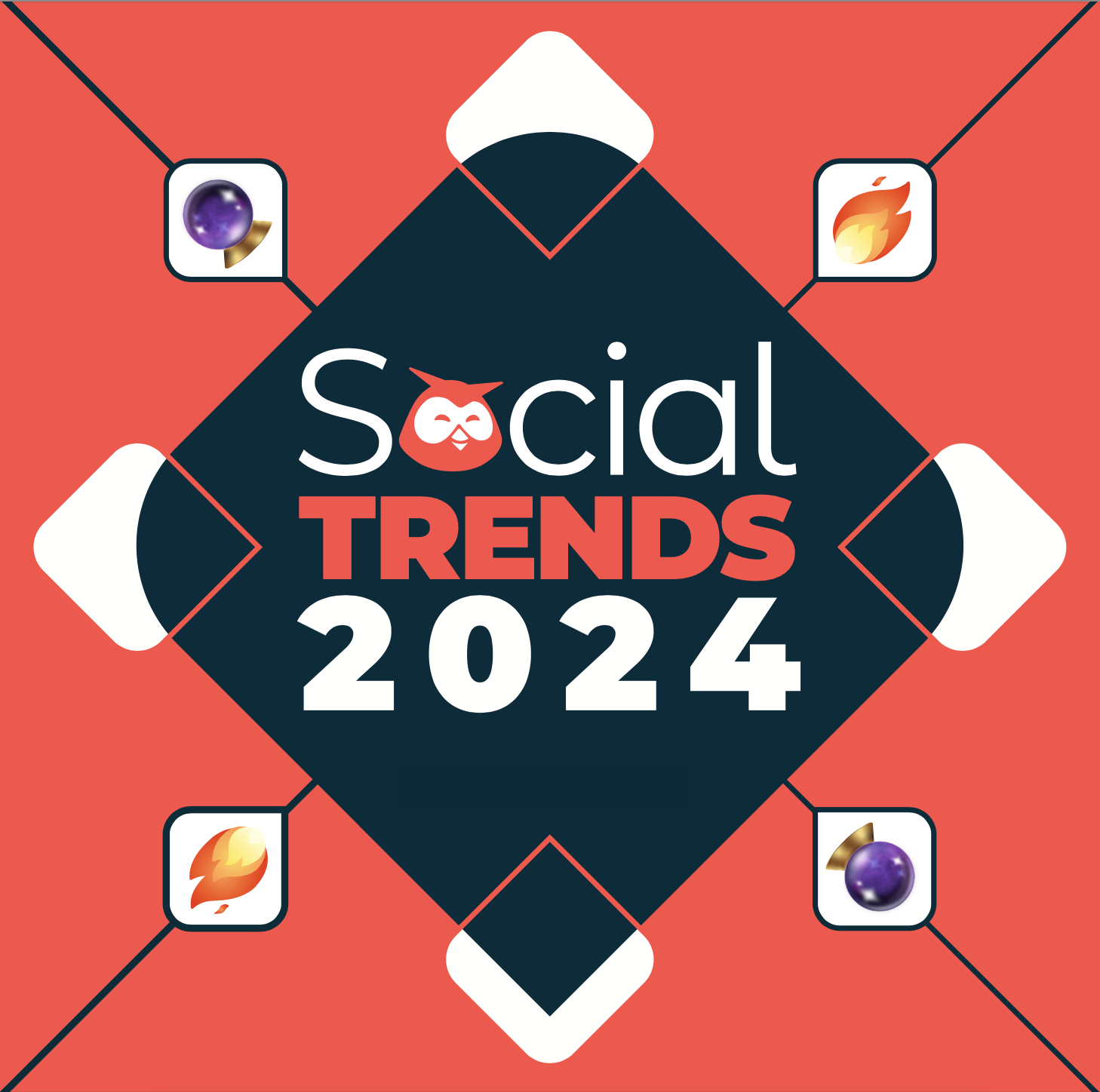
See the latest data and discover the top social media trends specific to education — and craft a strategy that’s too cool for school.
7. Create opportunities for active and passive learning
As an educator, you probably use a mix of active and passive learning.
Active learning requires students to actively engage with the lesson. This may be through discussions, challenges, or debates. You can even task your students with creating a photo or video essay hosted on a social media platform. Instagram is great for photo essays, while YouTube or TikTok work for video essays.
Passive learning requires learners to listen to lessons and absorb the information. Then, they must consider or translate the information. In classrooms, this might look like lectures and note-taking.
Social media poses an opportunity for both active and passive learning. For example, you could lecture your students on the dangers of misinformation on X. Then, task them to find a misinformed tweet and present their fact-checking process. Students will learn to examine data and provide evidence supporting their findings.
The combination of active and passive learning allows students to absorb information and then engage with what they’ve learned.
8. Teach networking and thought leadership skills
The working world is becoming more globalized and competitive every day. So, teaching students to develop networking and thought-leadership skills is essential.
By creating a LinkedIn profile and connecting with other professionals, students can:
- Learn how to build and nurture relationships
- Identify potential mentors
- Develop a personal brand
One way to do this is by sharing workshops on social media. Workshops offer a valuable opportunity for students to network, learn new skills, and form an opinion on a subject.

Source: Dougherty Arts Center on Facebook
Schools and educators can also use LinkedIn to show thought leadership in action. Your students, teachers, and departments can share resources, request feedback, and post relevant articles and videos.

Source: University of Southern California on LinkedIn
As students become more comfortable using LinkedIn, they can start exploring. Encourage them to follow other thought leaders and join conversations.
9. Develop discussion and critical thinking skills
Is your lesson goal to promote critical thinking? Then you might have students tweet their responses to weekly discussion prompts.
The limited character count will force students to be concise. They’ll have to identify their argument and communicate it without wasting words.
10. Celebrate student and alumni achievements
If you work in higher education , alumni relations are key to your social media strategy.
One way to engage both current and former students is to keep up with their achievements and post-graduate lives. You can do this by showcasing student news on your social media channels.
Not only does this reengage alumni and spark pride in current students, but it highlights your school’s impressive feats to the greater community.

Source: Texas State University on LinkedIn
A tool to help you use social media in education
Hootsuite can help make life a little easier. And with Hootsuite’s Student Program, qualified educators even get a deal!
Educators and administrators, here are four features that deserve your attention.
Scheduling capabilities
Scheduling all of your social posts in advance can help you save major time. If you’ve got a lot on your plate — as most educators do — this can be a huge help.
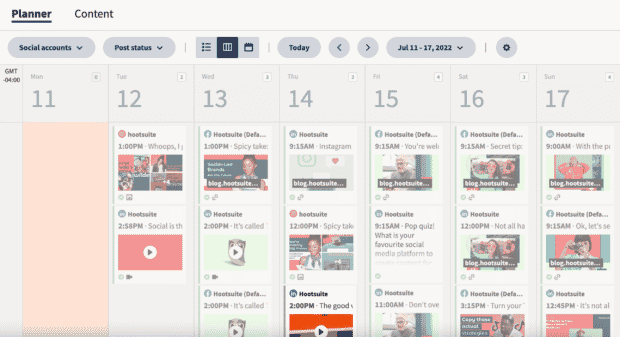
Hootsuite Planner’s calendar view makes it easy to see each post you’ve scheduled across every platform.
You can filter posts by account, drag and drop upcoming posts to new times or days, or easily duplicate recurring content — all from one simple dashboard.
Social listening
Hootsuite’s social listening tools help you analyze millions of online, real-time conversations.
You can use Streams to track topics that are relevant to your lessons or set alerts for your institution’s name. You’ll see what people are thinking and feeling, and you can use that data to influence your practices.
Hootsuite also integrates with more advanced social listening tools, like Talkwalker.
Talkwalker offers analytics related to social conversations beyond your owned social properties, including:
- Brand sentiment
- Important influencers
- Conversation clusters
Talkwalker is especially useful to spot activity peaks in conversations about your accounts. This can help you determine the best times for you to post on social media .
Psst: Hootsuite is set to acquire Talkwalker VERY SOON . This means that you will get access to Talkwalker social listening and analytics directly in your Hootsuite dashboard!
If you’re serious about using social, you’ll want to make time to review your work and make adjustments based on your findings.
Hootsuite’s Analytics can help you dig deep into the numbers and show you what’s working and what’s not with your social strategy.
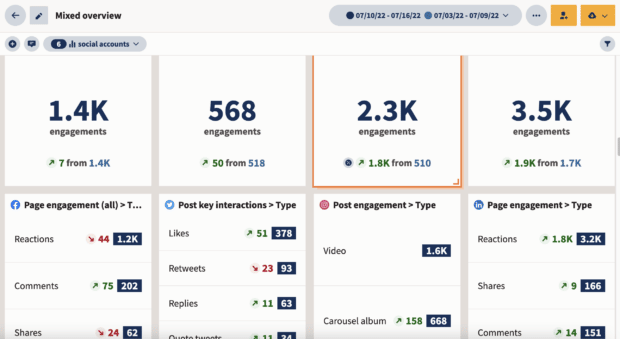
But analytics can also be a valuable teaching tool.
Understanding data analytics is a huge advantage, especially in our tech-forward age. Learning how to translate insight into action is a huge win. Students who understand how to interpret data are more employable, period.
Access to online courses
Want to take your social marketing to the next level? Hootsuite Academy offers on-demand video training to help you build your skills and engage with your audience. If you’re planning to teach with social media, these courses are a must-have.
Learn all the ways Hootsuite can help educational institutions improve their social efforts.
Using social media in education has never been easier. With Hootsuite, you can manage all of your social profiles, schedule and publish posts, engage your followers, monitor relevant conversations, analyze results, manage your ads, and much more — all from one simple dashboard. Try it free today.
Attract, recruit, and retain students with Hootsuite, the #1 social media tool for education .
Become a better social marketer.
Get expert social media advice delivered straight to your inbox.
Colleen Christison is a freelance copywriter, copy editor, and brand communications specialist. She spent the first six years of her career in award-winning agencies like Major Tom, writing for social media and websites and developing branding campaigns. Following her agency career, Colleen built her own writing practice, working with brands like Mission Hill Winery, The Prevail Project, and AntiSocial Media.
Sam Lauron is a freelance writer who works with B2B and SaaS companies in marketing, ecommerce, business, and related tech. With a background in editorial writing and content marketing, she uses her communications and research skills to produce helpful content that inspires and informs readers.
Related Articles

Social Media in Higher Education: 14 Essential Tips
As Gen Z goes to college, establishing a presence on social media has never been more important for higher education institutions.

15 Great Social Media Training Courses and Resources
Social media training courses are a great way for digital marketers to level up their skillset. Check out these great courses in 2023.

How to Use Social Media in Healthcare: Examples + Tips
There are many positive ways to use social media in healthcare, including promoting awareness and sharing accurate health messaging.

Social Media in Education: 13 Ideas for the Classroom

Since gaining widespread popularity in the early 2010s, social media has been a controversial topic when it comes to using it for education. However, many educators are now embracing social media as a teaching tool with a wide array of benefits for learning.
From parent-teacher communications to organizing group projects to developing digital literacy, social media has the potential to enhance the curriculum at any grade level — provided it is used responsibly. Here, we’ll explore eight platforms and five possible uses for social media in the classroom, plus some best practices for keeping it a safe and enjoyable experience for everyone.
How Social Media is Reshaping Education
Pros & cons of social media for students, 8 ways teachers can use social media in the classroom, 5 social media lesson ideas to try, faqs about social media in education.
As around 60% of the world’s population knows, social media can be an effective way to share news, find communities, build social networks and disseminate information instantly to a broad audience. According to Pew Research, 95% of American teens use at least one social media platform — so it makes sense that educators would seek to engage their students using technology they already interact with daily.
Teachers can use social media to organize group projects, communicate with students outside of class, share resources, and much more. Social media also has the potential to connect schools to the wider community for purposes including:
- Sharing school news
- Promoting school events
- Holding virtual town hall meetings
- Advertising fundraising initiatives
- Sending out emergency alerts
Since 90% of U.S. adults are also on social media (and many likely access it on their phones ), it is an incredibly useful medium for sending real-time communications to parents and guardians of school-aged children.
Of course, a tool as powerful as social media requires its users to exercise great responsibility to maintain a respectful, safe online environment. Teachers and students should be clear on both the benefits and risks before using these tools for educational purposes.
Benefits of social media in the classroom:
- Real-time communications can increase student engagement, collaboration, communication and overall participation.
- Many students may find it easier to participate in online discussions than in the classroom.
- Students can easily ask each other or their teacher questions about assignments outside of class.
- Students and teachers can quickly share helpful resources at any time.
- Teachers can easily share announcements with the entire class.
- Social media can provide a contingency plan for last-minute remote learning scenarios .
- Students can organize school events with each other or with the help of a teacher.
- Teachers can augment an online-only class by establishing a social media page or account strictly for building community.
- Students can practice using social platforms responsibly, including maintaining a respectful online discourse.
- Parents can stay informed of school news via a convenient, easily accessible platform.
- Teachers can communicate directly with parents as needed, especially if parents cannot attend an in-person meeting.
- Educators can build and enhance their own tech literacy skills to add to their portfolios.
- Most, if not all, social media platforms are free.
Downsides of using social media in the classroom:
- Social media can be a major distraction in class, especially if students are accessing their personal accounts independently. Private side conversations, off-topic activities and mindless scrolling can all happen when students are granted in-class internet access.
- If students primarily use social platforms to participate in class discussions, they can miss out on practicing face-to-face conversations and respectful in-person discourse.
- Some students may see social media assignments as an opportunity to cyberbully their classmates , so it’s critical that teachers set firm ground rules about responsible social media use.
- There is always a risk of a group member posting inappropriate content or language, since it is difficult to manage how students use social media platforms independently. Teachers must be responsible and attentive administrators to prevent and address inappropriate behavior.
While fewer school-aged young people are using Facebook today (about 32%, Pew finds), it can still be a useful tool for maintaining an online community, posting updates, sharing links and asking questions. Facebook can be used to organize specific projects, communicate with classes, form student clubs, plan events and more. The instant group chat function can facilitate real-time discussions, and Facebook Live enables teachers to lead virtual lessons, stream lectures and hold Q&A sessions. As administrators, teachers can set Facebook groups to private or invite-only to maintain a safe space for students.
Twitter can serve as more of a bite-sized message board where teachers can post short project updates, announcements, links to helpful resources or answer students’ questions. The platform can also serve as the basis for lessons in using concise language , since each post is limited to 280 characters — a valuable skill for both essay writing and future professional communications. Teachers can create dedicated handles or hashtags for each of their classes and invite both students and their guardians to follow along.
Blog posts provide another way for students to practice their essay writing, an increasingly important skill for higher grade levels. Instead of maintaining physical reading journals, students can submit weekly blog posts with their reflections and responses to assigned readings. Teachers can also use blogs to communicate project instructions during remote learning days or vacations and even write up a semester report for parents and guardians to review.
This is an excellent tool for sharing visual resources like infographics, artistic inspiration, tutorials or examples of finished projects. Many teachers use Pinterest to collect and organize their own lesson ideas, so creating a board (or several) where students can pin their own resources encourages collaboration and learning ownership. While students of all ages respond well to visuals, Pinterest may be particularly popular with younger students who are still practicing their reading skills.
Another great visual platform, Instagram can be useful for teachers to share updates, for administrators to post announcements and for students to post project results or follow accounts that are relevant to course content. Teachers can create class-specific accounts where they post assignments, instructions, resources, updates, and more.
This online community provides a space for anyone to unite around any interest imaginable — from fitness to classic film trivia to poetry. Reddit has a bit of an “anything goes” reputation for its lax posting guidelines, but moderators are typically on hand to mitigate any inappropriate or improper use of the platform. There’s a subreddit for every academic subject, so students can peruse threads for project research (while still verifying any information therein) and even post their own questions for the Reddit community to discuss.
Similar to Reddit, YouTube hosts video resources on any topic under the sun. Teachers can easily share educational videos, tutorials and any other type of video content. YouTube is also a great hosting platform for video projects, where students can upload finished videos for their teachers, classmates and guardians to watch on a private class channel.
This professional networking platform is mostly used by people in the post-school workforce, so high school students may not even be aware of it yet. However, whether they decide to attend college or not, learning how to market their skills and build a professional network can help students navigate the job market after graduation. LinkedIn is also a great place to find articles and other resources to help young professionals build their industry knowledge and skills.
The ideas in this section are merely suggestions for unique ways to use social media in the classroom — but the internet is your and your students’ playground! Use these ideas as jumping-off points for your own social media-based lessons.
- Use blogs to chart learning progress. Blogs can be useful tools for language learning, whether that’s practicing how to craft a five-paragraph essay or improving one’s French writing skills. But this long-form writing platform can also be used to track students’ progress in any subject. For example, have chemistry students write biweekly posts summarizing everything they’ve learned in class, and ask them to revisit and write about certain topics once a semester to practice knowledge retrieval. These posts can also serve as test prep and reminders of any concepts students may need to review.
- Use Instagram or TikTok for visual responses. Most social media platforms popular with young people are visual-based, meaning they rely on images and videos to convey information. Writing skills are essential for school, but sometimes it’s easier (and more fun) for students to engage with their learning using formats they’re more comfortable with. Instead of a written response to a textbook chapter, have students react using an appropriate TikTok trend. If students are required to show their work, ask them to create an Instagram carousel or Reel of their process and post it to a class-specific account.
- Use Twitter to illustrate the dangers of misinformation. Learning to find and cite accurate sources is a key skill for students, especially at higher grade levels. Unfortunately, misinformation is easy to encounter on social media, where anyone can make a claim or spread false information without providing a source. Show students an inaccurate tweet or other social post and ask them to verify or debunk its claims. Have them document their research process and cite the sources they used to fact-check the post.
- Use LinkedIn to help older students craft their resumes. Marketing themselves in a professional sense isn’t always a skill young people learn in school, but it’s a skill that proves useful for nearly every adult. Have students use LinkedIn to craft a professional objective, organize and explain their work and educational experiences, ask for recommendations and start making connections with potential mentors and employers.
Best Practices for Social Media in Education
For many young people, social media is a part of their (and their parents’) everyday lives. Chances are, if a teacher chooses to incorporate social media into a lesson, many students will already be familiar with the platform and how to use it. Since students may be accustomed to using social media outside of an educational context, it’s crucial that teachers set ground rules and expectations for the appropriate use of these tools.
The following are some best practices that will keep social media a safe and productive place for students and their teachers:
Set professional boundaries: Many teachers also likely have personal social media accounts, so when using these platforms for lessons, it’s best to create an entirely new account dedicated solely to academics. Keep accounts private and invitation-only so that no one besides students and their parents can access the content. No one, teachers included, should be posting anything about their personal lives or content that is unrelated to the course. Invite students to create new user accounts as well to avoid mixing their personal and academic business.
Prioritize increasing digital literacy: Generations of digital natives (including today’s school-aged children and many of their parents) have likely already been practicing online etiquette, but it never hurts to review both practical and appropriate ways to use social media. Remind students that anything they post online has the potential to exist forever, which becomes especially important as they begin to apply to colleges and search for jobs. Students should conduct themselves online just as they are expected to in school.
Promote student achievements: You and your students put in a lot of work during the school year — share your accomplishments with the community! If your school has a public social media account, provide the account manager with information about your class’s latest project or an upcoming showcase so members of the community can see what students have been up to. Not only does this give students an opportunity to show off their work, but it also serves as promotional information for anyone considering enrolling their own children in the school.
Manage multiple accounts from the same place: If you manage multiple accounts for one or more classes, use a tool like Hootsuite or Facebook Publishing (which integrates Facebook and Instagram) to draft and schedule posts for multiple platforms at once. This is especially helpful when students and parents need the same information, but each group predominantly uses a different platform.
Part of a teacher’s job is to never stop learning, whether it’s about the subject matter they teach, new educational tools or innovative ways to engage students. The University of San Diego offers multiple courses for educators in the Professional and Continuing Education program, including classes covering educational technology , digital literacy , equity in the classroom and more. USD also offers certificate programs that focus on specific aspects of education, so that teachers can build a suite of skills in areas like STEAM education or supporting English language learners .
For a full range of USD courses available through the PCE program, explore all course offerings here .

How can I ensure students’ safety on social media?
To protect students’ privacy, keep all class-related social media accounts private or invitation-only and encourage them to set their own accounts to private or create new class-specific profiles. Review proper online etiquette and behavior with students and establish firm consequences for cyberbullying. As a teacher, it’s critical to maintain professional boundaries online, so avoid discussing or posting anything personal on school social media accounts. You may even want to grant access to students’ parents so they can monitor how their children are using these spaces.
How can I use TikTok in my lessons?
According to Pew Research, 67% of U.S. teens use TikTok , with 16% on the app almost constantly. Since so many students already gather in this digital space, teachers can engage them by creatively incorporating it into lessons. Ask students to film reactions to course content using TikTok trends, conduct research via subject matter experts’ posts, or create response videos in place of traditional project reports.
Which social media platform is best for communicating with parents?
It depends on what kinds of content you want to share and which platforms parents and guardians are comfortable using. At the beginning of each school year, send out a survey asking parents to indicate their preferred social media platform, then use the top two results for parent-facing communications. With so many people on multiple social media platforms, it’s best not to limit school news to just one; fortunately, managing multiple accounts at once is simple with social media management tools like Hootsuite and Facebook Publishing.
5 REASONS WHY CONTINUING EDUCATION MATTERS FOR EDUCATORS
Download eBook: 5 Reasons Why Continuing Education Matters for Educators
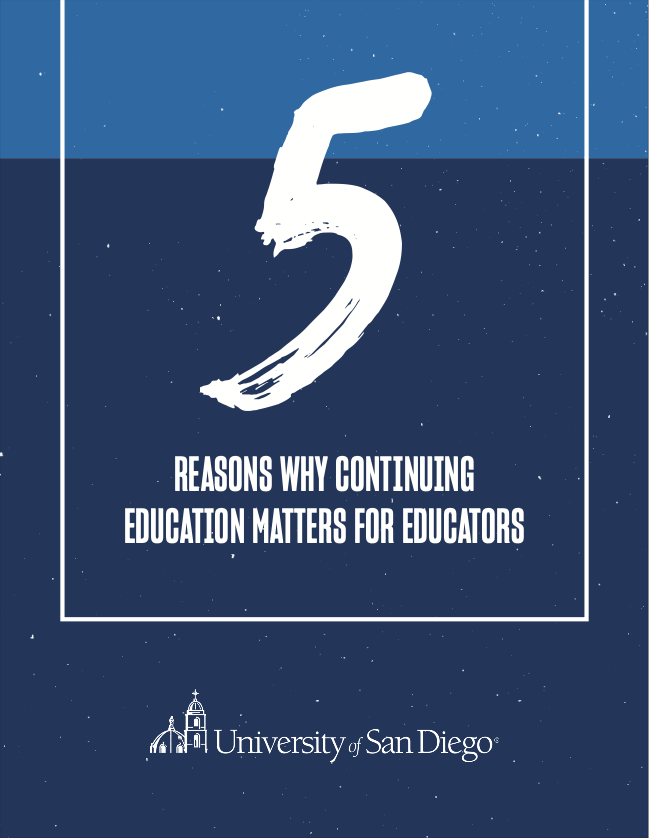
Curriculum covered in this article
Educator Programs – 25% Off Teachers Appreciation Sale
Valid May 1, 2024 – May 31, 2024
Some restrictions apply. Offer valid only during sale dates. Not all courses apply. **Only one discount can be applied per course.**
Be Sure To Share This Article
- Share on Twitter
- Share on Facebook
- Share on LinkedIn
Teaching with Social Media
Statement on guidelines for the use of social media as an instructional tool.
The Committee on Courses of Instruction (COCI) in consultation with the Center for Teaching and Learning (CTL), Educational Technology Services (ETS), and the Privacy Office recognize that social media are embedded into the lives of many 21st century students. In recent months COCI has received proposals for new courses that include the use of third party social media platforms that are not licensed by the University as part of the instructional activities. COCI recognizes that the use of social media as a communication channel can help create a collaborative learning environment and engage students in a discussion of course topics in a more dynamic and current, authentic way. Instructional staff (e.g. professors, lecturers, graduate instructors, etc.) earnestly work to keep their curriculum relevant and to find timely ways to engage students in course topics. However, requiring students to register for, post, upload, or otherwise communicate via a social media platforms not licensed by the University (such as Facebook, Twitter, Piazza, and many others) raise concerns about privacy, accessibility, and equity that make such required assignments potentially problematic.
COCI asks that instructors first and foremost consider the question: Does your use of the social media platform adhere to the Family Educational Rights and Privacy Act (FERPA)? It is the instructor’s responsibility to adhere to FERPA. Among other items, student records that are protected under FERPA include: grades, class lists, and schedules. Participating in a social media platform as part of a class assignment could potentially disclose a student’s class enrollment. Comments or feedback on social media could disclose a student grade. Or class activity planning via social media (e.g. field trips, outside research, etc) could disclose a student’s schedule. Each scenario places the student, instructor, and University at risk.
Furthermore, COCI recommends that instructors consider the following questions as they contemplate using social media in their pedagogy:
1. What pedagogical enhancement does the assignment gain by being on a third party social media platform? When thinking about using a social medium it is important to have a clear objective and understanding of how this medium will enhance or be a value-add to the course instruction. Tools and applications that are licensed by the campus may suit your pedagogical goals in a fairly similar manner but include the added benefit of having been reviewed for adherence to the Family Educational Rights and Privacy Act (FERPA) and privacy concerns.
2. Is the functionality you need available in an application either produced or licensed by the University that can support the same outcome? If the University provides or licenses a service that allows for the same, or equivalent, benefit as the third party social media platform, the University service should preempt any third party tool. This helps to ensure that University policy, protections, and support is provided to the instructional activity.
3. What is the vendor/company doing with the information they are collecting about the student? Facebook is an obvious case where the company markets directly to account holders. There are also platforms that market “free” tools for instructors and students directly applicable to online learning. However, these companies sometimes/often are mining the data generated by students to use as a revenue generation tool (e.g. providing it to potential employers).
4. What tools are being provided by the instructor/university, or must students have personal access in order to participate? Some social media forums are multidevice functional and transition easily from laptop to smartphone to tablet. Some are solely designed for single device use. Willingness by students to use social media does not necessarily equate with all students being able to access the tool equally. Also, social media platforms may not support the assistive technology tools used by students who experience disabilities. Students who are unable to or unwilling to access the social media platform may feel they have no choice, or are being singled out unfairly.
5. What are the long-term ramifications of the assignment? Part of the experience of college is for students to explore their own ideas and opinions that may transform over their time at Berkeley and beyond. The permanency of social media means that a single comment posted today can follow the student across their entire life. As an example, many employers now research a potential candidate’s social media profile(s) prior to making hiring decisions.
In the same measure, some students curate their social media persona very carefully, choosing to promote political, social, and personal beliefs in very specific ways. Engaging in a class assignment may not align with individual expressions the student has self-established. Issues of constitutionally protected freedoms and highly valued academic expression freedoms become relevant in this scenario. With many third-party platforms requiring the use of real names, the ability of a student to use an alias or pseudonym may not be viable under the legal terms of the third party platform. Knowing that these questions are broad and that the nature of social media is ever changing, the Center for Teaching and Learning has established a repository of resources for instructors to find more support (see: http://teaching.berkeley.edu/teaching-socialmedia ).
Resources on Teaching With Social Media
Tips from Social Media for Educators: Strategies and Best Practices
8 Things You Should Know Before Using Social Media in Your Course
Learning in Bursts: Microlearning with Social Media
(includes privacy considerations and partial mitigations for Twitter, Instagram and Facebook)
FERPA and Social Media
I s Your Use of Social Media FERPA Compliant?
Pros and Cons of Social Media in the Classroom
Consenting Adults? Privacy in an Age of Liberated Learning Data
Overcoming Hurdles to Social Media in Education
Facebook 'real name' policy stirs questions around identity
Repository of Campus Policies and Other Guides
Berkeley Privacy Office
Educational Technology Services
Residential Computing: Resources
UC Statement on Privacy Values
UC Berkeley Social Media Guidelines
UC Statement of Privacy Values and UC Privacy Principles
UC Principles of Community

How Social Media is Reshaping Today’s Education System
by Lori Wade
There’s no denying that, ever since social networks and social media made way into our lives, everything is different. Beginning with the way we socialize, interact, plan for parties or even how often we go out. We won’t go into a debate regarding the ethical aspects of the way Social Media is influencing our lives. Instead, this article proposes to focus on the numerous ways in which social media is changing the way the education system works. So, stay tuned to find out what effects does social networking have on the way our children are educated both at school and outside of it.
Empowering Effects Starting from elementary school up until university graduation, social media has the role to empower parents, students and teachers to use new ways of sharing information and build a community. Statistics show that 96% of the students that have internet access are using at least one social network . What’s even more extraordinary is that, even though some of the students use the social networks for entertaining and other purposes, there are a lot of them that actually use it to promote a lot of positive and useful activities. From finding a summer internship, promoting a success story about how to win the student-loan battle or collaborate on international projects, everything is made possible.
Implementation in Schools? When it comes to social media, schools tend to adopt different positions. It’s a general consensus that they’re useful when it comes to sharing information or organizing the school tasks. And at the same time, the social networking is blamed for the lack of attention in students during classes.
But an increasing trend of adopting social media in school is starting to show. And since students already devote a lot of time for social media and connecting with others outside school hours, why not do it during school as well?
It’s a matter of practicability, really, because it makes perfect sense to use the online universe to communicate with your students since they’re already there most of the time. There’s no need for another case study about the usage of social media in schools. You simply need to walk through the hallways of any school or colleague to see kids of all ages totally immersed in their smartphones. Browsing their news feed, sharing photos on Instagram of sending Snapchat messages has become a part of their daily routine.
How Can Teachers Penetrate the Online World? Moodle and Blackboard are just two examples of learning management system that involves online learning for more than 10 years now. Slowly but steady, such systems will lead to the actual implementation of social media within classrooms. And the best tool available for teachers is social media itself. Only by being open-minded and using the technology themselves will they be able to really reach out to students.
“ The best teachers I’ve ever had have used technology to enhance the learning process, including Facebook pages and events for upcoming projects” – Katie Benmar, Freshman
As the above statement emphasizes, students also react very positively when a teacher is willing to use their methods and adapt them as part of the educational process. And it makes perfect sense since a homework has a certain strictness about it, but an online chat discussing a certain book gives students the ability to open up and share their opinions.
Daring Teachers Of course, the examples of teachers already implementing social media in classes are far numerous that we can know of, however, there are a few that did such a great job that their students almost made them viral. For example, a biology teacher from Bergen County proposed a challenge to his students. They had to debate over the subject of meiosis on Twitter by using a specific hashtag. This is a great opportunity for students to have fun and learn at the same time. As you need to know your meiosis in order to compress it into 140 characters.
“ We live in a digital ecosystem, and it is vital that educational institutions adapt ”
Carla Dawson – Digital Marketing Professor at the Catholic University of Cordoba
Professor Dawson really has a valid point there as history showed us all that, no matter how strong the resistance, technological progress and new trends will eventually become a standard. Of course, this applies to developed countries that already have a well-structured traditional educational system. It’s a totally different situation when it comes to developing countries that are still struggling to find their way.
A Stronger Community Through Social Media The benefits of social media in the education process doesn’t have to stop at the teacher-student relationship. There are a lot of other benefits that can be extracted from the use of social networking at higher levels as well. For example, principals or administrators can find a new way to integrate social media. Like sharing school news via social networks, holding online meeting with the parents or even starting fundraising for different projects.
And social media can quickly become the only channel of communication since we’re living fast-paced lives, parents are usually busy with work and cannot attend school meetings. But this doesn’t mean they shouldn’t be in touch with events or be able to check on their kids every once in awhile. Just like in every other field, communication is vital and if it can be done easily with the help of social media, why not go for it?
It may not be criteria just yet, but soon enough questions like ‘Does this school have a Facebook page?’ could become just as important as the things that parents are asking right now. Like, how well equipped the library is or what are the optional classes their child can be part of.
Conclusions The bottom line is that social media is a big part of our day to day life and there’s no point of keeping it away from the education process. School, college and university staff should be encouraged to make use of technology for student and parent communication. This could easily turn into an argumentative essay topic for college . But the benefits are obvious, starting with healthier parent-teacher relationships and all the way to permanently changing the way our children will learn.

Social Media in the Classroom: Opportunities, Challenges & Recommendations
- On This Page
Opportunities & Challenges with Social Media
Recommendations for using social media in the classroom, social media faq.
The EDUCAUSE Center for Analysis and Research (ECAR) conducts an annual survey of over 250 institutions of higher education, including the University of Washington, examining the technology experiences of undergraduates and faculty. A recent ECAR survey included questions exploring faculty and student perceptions of and experiences with social media as an academic resource. While the ECAR findings raise more questions than they answer, there is significant evidence that UW faculty and students are interested in the potential utility of social media as a learning tool. Read on for to learn about opportunities and challenges with social media in the classroom as well as recommendations, authored in consultation with the University Registrar, for incorporating the use of social media in academic work.
View/Download a PDF version

Considering both the potential opportunities and challenges in using social media as an educational tool, UW instructors should take steps to ensure successful adoption in the classroom. Fortunately, best practices and guidelines can help set appropriate expectations for using social media in teaching and learning. These recommendations, created in consultation with the University Registrar, address actions that can be taken by instructors.
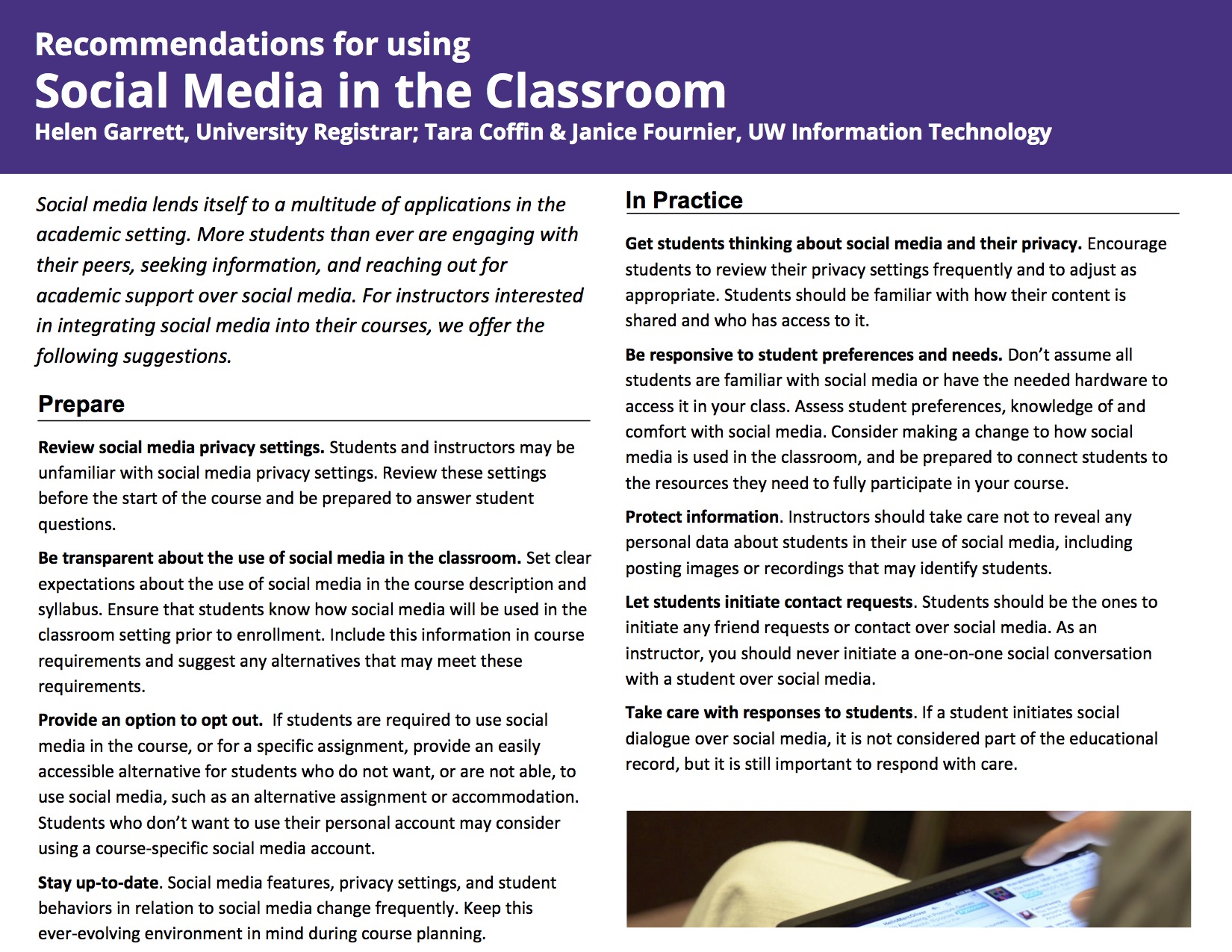
What is social media?
Social media is a communication tool that allows users to interact with, and contribute to, content online. It includes popular online social networks such as Pinterest, Twitter, Instagram, YouTube, and Facebook, with new platforms emerging. Although social media has a large presence in news and entertainment, when used in the learning setting for educational purposes it has the potential to facilitate communication, augmenting the student experience and improving outcomes, by:
- Encouraging interaction and engagement among students
- Nurturing a student-centric learning setting
- Extending the learning environment beyond the classroom
- Facilitating the flow of information between students, faculty, and the campus community
Why would I use social media in my teaching?
Current research suggests that in the higher education setting, social media may be used to improve communication between students, instructors, and the surrounding campus community. While many different types of communication tools are available in the learning setting, the advantage of using popular social media platforms is that most students arrive to campus as fluent users of these virtual tools. Whether or not instructors adopt social media as an education tool, chances are their students already have created a class-specific Facebook group, use Twitter to share course information, or use another social media platform to communicate with other students outside of class.
Do I need to be concerned about privacy?
It’s best to view anything posted to social media as publicly available information, and treat content accordingly. While many social media platforms, such as Facebook, provide users with the ability to filter who is able to see their content, it is difficult to ensure privacy. Once posted, social media content is held by a third party, and the user more or less relinquishes ownership in exchange for free storage.
What can I do to protect my privacy?
Instructors and students should familiarize themselves with social media platform-specific privacy settings, and stay up-to-date with them. Many social media platforms enable the user to determine how widely their content is shared, restricting access to a designated group or making content publicly accessible. While these settings offer some degree of protection, there’s no guarantee that anything posted to a social media platform is actually private, so best practice is to treat any posts as public.
Some students and instructors might prefer to compartmentalize their online social and academic lives by creating separate accounts for coursework. Over Twitter for example, instructors can offer students access to a shared class account, using a handle or username associated with the course itself, e.g. @Bio101. In this case, students would all have access to the same account, utilizing this account to contribute to discussion and post content. Over Facebook, instructors and students may opt to create a group or page specific for class. While these social media groups can be set to “private” or “secret,” enabling instructors and students to control who has access to them, instructors should continue to collaborate with their colleagues, TAs, and students for ideas on preserving privacy.
What should I do to protect student privacy?
In addition to the above recommendations, instructors need to be mindful of what type of content they post to and about their students. Posts should not include any personal data about students, including images, recordings, or any documentation related to a student’s performance in class.
Protecting student privacy also means that instructors model positive social media practices and privacy considerations in class. When using social media for a class-related activity, instructors should talk to their students about social media and privacy, and encourage students to keep themselves up-to-date with changing privacy policies.
How should I communicate how social media will be used in the classroom, to my students?
However you choose to communicate expectations about how social media will be used in the course, it is essential to make students aware of these expectations as early as possible, equipping students with the information they need to make informed choices about their course schedule. Instructors may opt to clarify expectations in the course description, so students are aware even before enrollment. Such expectations can also be detailed in an accessible course Canvas page, over MyPlan, or in course marketing materials. Students should have a clear idea about how social media is used, if it is required, and what, if any, accommodations or alternative assignments are available.
What are some ways I can use social media in my courses?
One way to begin integrating social media into the classroom is to ask other instructors, TAs or students what they are doing. In addition to these sources, here are some ideas for ways instructors can use social media as a teaching and learning tool:
- Implementing Live Twitter Chat Discussion Sessions
- Teaching with Twitter: Podcast and getting started
- How Social Media Can Help Students Study
- Collaborative Online Projects: Wikis
- Keeping remote collect students connected: Virtual student unions provide communities for online learners
- Social Media: A tool to increase college students’ engagement and success
- Facebook groups as LMS
- How-to use social media platforms to create meaningful learning assignments
- Virtual office hours
- The impact of social media on the dissemination of research: results of an experiment
- Our Mission
Understanding the Science of Social Media
Schools can play a big role in educating students and their families about the potential pitfalls of social media.
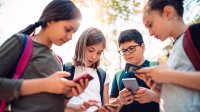
Author and futurist Brian Solis has said that “social media is more about sociology and psychology than technology.” To take that a step further, social media really comes down to neurology—to how it influences our brains. Researchers have found a link between the amount of time adolescents spend on social media and their levels of depression , particularly among girls, and Jean Twenge, a professor of psychology, asserts that social media is the reason for a drastic uptick in mental health issues among children.
Social media has become so much of a concern that the U.S. surgeon general declared that no one under the age of 14 should be on social media , and states are starting to take action to limit usage and hold social media companies accountable.
As educators know, schools are facing unprecedented amounts of student mental health and misconduct issues with strong connections to social media. School leaders are at a loss trying to keep up with these issues. Doing so will take a multifaceted approach to address the social media crisis among students. The first step is awareness of social media’s influence on the brain, followed by educating students and parents on ways to navigate these troubled waters.
What’s Behind Our Need for Social Media?
Why is it so easy to fall into a TikTok rabbit hole? You know these situations when you spend hours mindlessly scrolling Facebook, Instagram, etc., with no sense of time. One reason could be the influence that social media has on a chemical neurotransmitter in your brain.
Dopamine is a powerful and important neurotransmitter. It’s known as the “get up and go” or “pursuit” neurotransmitter. It motivates us to get things done. We feel our best when our dopamine level is associated with extended periods of effort. Our dopamine level goes out of whack when we receive repeated “dopamine hits” with little to no effort at all. When this occurs, the dopamine is in control of us, leading to compulsive behaviors.
Daniel Z. Lieberman, MD, asserts that there are peripersonal and extrapersonal spaces . Your peripersonal space includes items on your person or within your reach. Items in your extrapersonal space are literally out of reach. A hunter going out in the woods to hunt requires extended periods of effort to do so. Dopamine will be released over that period of time in anticipation of the hunt. The deer is out of the hunter’s reach; therefore, it exists in extrapersonal space. Once the hunter has the deer, it’s in peripersonal space, and dopamine shuts off.
So how is all this related to social media? Social media content falls under extrapersonal space. There is something always there, and dopamine is constantly pursuing it. As more and more dopamine gets released, your threshold increases, making it more and more difficult to feel accomplished. You end up compulsively scrolling and scrolling .
Social media is designed to keep our interest through the use of powerful artificial intelligence algorithms. These algorithms will quickly probe you to determine your interests. Ultimately, they are seeking to get your dopamine levels up, so you go into pursuit mode. The ease of access and endless quantity is what especially complicates the addictive behaviors associated with social media.
How can we expect our students (and their parents) to understand how to navigate those social media waters without this understanding?
Social Media Education
Schools are ideally set up to help educate youth and the community to bring about an awareness of the driving force behind social media and provide practical safeguards. Offering health classes or having the school counselor teach lessons is a good place to start, as early as elementary school. It’s important to note that when these topics are discussed in class, information should also be sent home.
Common Sense Media has lots of free information and resources to help teachers and school administrators educate students and parents on digital citizenship, including social media. In particular, they have self-paced trainings and videos.
Lesson topics should include the following elements.
Usage limits: The U.S. surgeon general recommends that children under the age of 14 should not be on social media; most social media apps set the age requirement at 13+.
If a parent is comfortable with age 14, then a daily usage limit is the next step. Increased social media use has been associated with higher levels of mental health issues , decreased academic performance, lack of exercise, and general decreased well-being. Therefore, children should be limited to 30–60 minutes a day to help avoid those issues. Both Google and Apple have screen time trackers to help parents or guardians monitor usage.
Appropriate conduct and safety: Digital etiquette and conduct while online is an integral piece of the education program. Students should be encouraged to sign a safety contract with their parents or guardians, and they should learn how to be a good digital citizen, how to identify and respond to grooming and predatory behaviors, and the dangers of sexting.
How to report cyberbullying or harassment: Inevitably, students will encounter some form of cyberbullying or harassment while online, as either a victim or a bystander. Steps should include:
- Do not respond.
- Save the evidence.
- Report it directly to the app company .
- Contact the local police department if it involves a threat or ongoing harassment.
- Notify the school’s principal if it’s associated with the school.
Yearly Parent Informational Meeting
A yearly informational meeting should be held with your building’s parent group, covering the following topics:
- Science behind social media
- Social media apps and trends
- How to implement a phone’s parental controls ( Apple and Google Play )
- Turning off location sharing to social media apps ( Apple and Android )
- How to report inappropriate social media use
- External parental control software options
- Social media tips for parents
All educators and school leaders are urged to recognize their roles and responsibilities in better educating their students and in turn the community. Together, we can best help our youth and counter some of these troubling trends.
Study On Relationship Between Social Media and Its Usage by The Teachers of Higher Education Institutions
Article sidebar, main article content.
The purpose of the study is to analyze the relation that exist between time, age and gender of the employees of higher education institutions and differences in usage pattern of social media and any relationship if exits between the perceived usefulness and productivity of employees with respect to social media platforms. Employees from reputed higher education institutions from 4 cities of Uttar Pradesh namely Agra, Kanpur, Lucknow and Prayagraj were taken as population. Primary data was collected from teaching faculty of the given institutions through random sampling. The aggregate number of respondents for the research work 524. Hypothesis testing was done by using Spearman’s Rho formula. The study provides an insight about how the mentioned factors affect the social media usage as it has always been a matter of debate.
Article Details
Harshit eric williams.
Assistant Professor, JSBS & C, SHUATS University, Prayagraj, U.P, India.
Sarah Chirag Din Massey
Assistant Professor, JSBS & C, SHUATS University, Prayagraj, U.P, India. Principal, St. Mark’s International School, Prayagraj, U.P, India.

Similar Articles
- Muhammad Usama, Hamza Imran, Dr. Mohammad Shakeel, Faisal Javed, Dr. Iram Yasir, Association Of Red Meat Consumption With Colorectal Carcinoma In Islamabad , Educational Administration: Theory and Practice: Vol. 30 No. 5 (2024): In-Press
You may also start an advanced similarity search for this article.
Most read articles by the same author(s)
- Harshit Eric Williams, Sarah ChiragDin Massey, Study On Relationship Between Social Media And Its Usage By The Teachers Of Higher Education Institutions , Educational Administration: Theory and Practice: Vol. 30 No. 5 (2024): In-Press
Howard Gardner
Faculty info, contact information, personal site, faculty coordinator.
Howard Gardner is the John H. and Elisabeth A. Hobbs Research Professor of Cognition and Education at the Harvard Graduate School of Education. He is also the head of the Steering Committee of Harvard Project Zero . Among numerous honors, Gardner received a MacArthur Prize Fellowship and a Fellowship from the John S. Guggenheim Memorial Foundation in 1981 and 2000, respectively. In 1990, he was the first American to receive the University of Louisville's Grawemeyer Award in Education. He also won Howard Gardner, recipient of the Distinguished Contributions to Research in Education Award. In recognition of his contributions to both academic theory and public policy, he has received honorary degrees from thirty-one colleges and universities, including institutions in Bulgaria, Canada, Chile, Greece, Ireland, Israel, Italy, South Korea, and Spain. He has twice been selected by Foreign Policy and Prospect magazines as one of 100 most influential public intellectuals in the world. In 2011, Gardner received the Prince of Asturias Award for Social Sciences; in 2015, he was chosen as the recipient of the Brock International Prize in Education; and in 2020, he received the Distinguished Contributions to Research in Education Award from the American Educational Research Association (AERA). He has been elected a member of the American Academy of Arts and Sciences, the American Philosophical Society, the National Academy of Education, and the London-based Royal Society for the Encouragement of Arts, Manufactures, and Commerce.
The author of thirty books translated into thirty-two languages, and several hundred articles, Gardner is best known in educational circles for his theory of multiple intelligences, a critique of the notion that there exists but a single human intelligence that can be assessed by standard psychometric instruments (please see Multiple Intelligences Oasis ). Since the middle 1990s, Gardner has directed The Good Project , a group of initiatives, founded in collaboration with psychologists Mihaly Csikszentmihalyi and William Damon.
In 2020, Gardner’s memoir, A Synthesizing Mind was published by MIT Press. He also recently completed The Real World of College with Wendy Fischman, to be published by MIT Press in 2022. This book explores the results of their large-scale national study documenting how different groups think about the goals of college and the value of a course of study emphasizing liberal arts and sciences. He contributes to his personal blog regularly.
Publications
- Kornhaber, M., & Winner, E. (Eds.). (2014). Mind, Work, and Life: A Festschrift on the Occasion of Howard Gardners 70th Birthday, with responses by Howard Gardner (Vols. 1-2). Amazon via CreateSpace Independent Publishing Platform. Available online at: http://howardgardner01.files.wordpress.com/2012/06/festschrift-_-volumes-1-2-_-final.pdf.
- Gardner, H. and Davis, K. (2013). The App Generation: How today's youth navigate identity, intimacy, and imagination in a digital world . New Haven, CT: Yale University Press. Translated into: Italian, Korean, Spanish, Romanian, and Chinese (simple characters).
- Gardner, H. (2011). Truth, beauty, and goodness reframed: Educating for the virtues in the era of truthiness and twitter . (Paperback edition, with new preface). New York, NY: Basic Books.
- James, C., Davis, K., Flores, A., Francis, J., Pettingill, L., Rundle, M., & Gardner, H. (2009). Young people, ethics, and the new digital media: A synthesis from the GoodPlay Project . Cambridge, MA: The MIT Press.
- Gardner, H. (2007). Five minds for the future . Boston: Harvard Business School Press. Translated into Korean, Italian, Japanese, Danish Chinese, Portuguese, Russian, Spanish, Turkish, Romanian.
- Gardner, H., Ed. (2007). Responsibility at work: How leading professionals act (or don't act) responsibly . San Francisco: Jossey-Bass.
- Gardner, H. (2006). The development and education of the mind: The collected works of Howard Gardner . London, UK: Routledge. Translated into Italian, Spanish.
- Gardner, H. (2006). Multiple intelligences: New horizons . New York: Basic Books. Translated into: Romanian, Chinese (SC), Vietnamese, Indonesian, Korean, and Bulgarian.
- Gardner, H. (2004). Changing minds: The art and science of changing our own and other peoples minds . Boston MA: Harvard Business School Press. Paperback edition (2006). Translated into French, Spanish, Japanese, Danish, Indonesian, Italian, Korean, Portuguese, Greek, Polish, Russian, Turkish, Chinese (CC), Chinese (SC), Chinese (short version), Danish, Romanian, Norwegian, and Croatian. Awarded Strategy + Business's Best Business Books of the Year (2004). 2011 Edition with updated preface and bibliography: New York, NY, Basic Books.
- Fischman, W., Solomon, B., Greenspan, D., Gardner, H. (2004). Making good: How young people cope with moral dilemmas at work . Cambridge: Harvard University Press. Translated into Spanish, Korean, and Chinese.
- Gardner, H. (2002). Howard Gardner in Hong Kong . L.Lo (Ed.). Hong Kong: Hong Kong Institute of Educational Research.
- Gardner, H., Csikszentmihalyi, M. and Damon, W. (2001). Good Work: When excellence and ethics meet . New York: Basic Books. Paperback edition with Afterword (2002). Translated into Korean, Spanish, German, Portuguese, Swedish, Chinese and Romanian. Selected as one of ten most important books in Hong Kong (2003). Chosen as a Book of Distinction by the Templeton Foundation.
- Gardner, H. (1999). The Disciplined mind: What all students should understand . New York: Simon and Schuster. Translated into Portuguese, German, Spanish, Chinese (Taiwan), Italian, Swedish, Korean, Hebrew, Danish, Turkish, Romanian, Croatian. Excerpted in The Futurist , 34, (2), 30-32, (Mar/Apr 2000) . Paperback edition with new afterword, "A Tale of Two Barns": Penguin Putnam, New York, 2000.
- Gardner, H. (1999). Intelligence reframed: Multiple intelligences for the 21st Century . New York, NY: Basic Books. Translated into German, Spanish, Korean, Hebrew, Chinese (SC), Swedish, Portuguese, Japanese, Italian, Bulgarian, Polish, Turkish, Dutch, and Croatian.
- Gardner, H. (1997). Extraordinary minds: Portraits of exceptional individuals and an examination of our extraordinariness . New York: Basic Books. British edition, London: Weidenfeld & Nicolson, 1997. Translated into French, Portuguese, Chinese (Taiwan), Chinese (PRC), Polish, Hungarian, Czech, Spanish, Korean, Indonesian, and German.
- Gardner, H., with the collaboration of Laskin, E. (1995). Leading minds: An anatomy of leadership . New York: Basic Books. Translated into German, Italian, Swedish, Portuguese, Chinese (Taiwan), Greek, Korean, Spanish, and Japanese. British Edition: HarperCollins, 1996. Basic Books Paperback.
- Gardner, H. (1993). Multiple intelligences: The theory in practice . New York: Basic Books. Selected by three book clubs. Excerpted in the magazine Behinderte in Familie , Schule und Gesellschaft , vol. 2 , 1997. Abridged, Danish translation, 1997, Copenhagen: Glydendal Undervisning. Translated into Spanish, Portuguese, Italian, French, Chinese (Taiwan), Hebrew, Korean, Polish, Chinese (R.C.), Danish, Ukranian, and Japanese.
- Gardner, H. (1993). Creating minds: An anatomy of creativity seen through the lives of Freud, Einstein, Picasso, Stravinsky, Eliot, Graham, and Gandhi . New York: Basic Books. Quality Paperback Book Club. Translated into Swedish, German, Spanish, Chinese (Taiwan), Portuguese, Italian, Slovenian, Korean, Polish, and French.
- Gardner, H. (1990). Art education and human development . Los Angeles, CA: The Getty Center for Education in the Arts. Translated into Italian and Spanish.
- Gardner, H. (1989). To open minds: Chinese clues to the dilemma of contemporary education . New York, NY: Basic Books. Basic Books Paperback with new introduction, 1991. Translated into Italian and Korean.
- Gardner, H. (1985). The mind's new science: A history of the cognitive revolution . New York: Basic Books. Translated into Spanish, Japanese, French, German, Italian, Chinese, and Portuguese. Adopted by six book clubs. Basic Books Paperback with new Epilogue, 1987.
- Gardner, H. (1983). Frames of mind: The theory of multiple intelligences . New York: Basic Books. Selected by five book clubs. British Edition, W. Heinemann. Translated into Spanish, Japanese, Italian, Hebrew, Chinese, French, and German. Basic Books Paperback, 1985. Tenth Anniversary Edition with new introduction, New York: Basic Books, 1993. Twentieth Anniversary Edition with new introduction. New York: Basic Books, 2004. Translated into Swedish, German, Portuguese, Spanish, Italian, Chinese (Taiwan), French, Norwegian, Hebrew, Slovenian, Korean, and Czech. Selected by three book clubs. Selected by the Museum of Education for Books of the Century exhibit, Columbia, SC, 1999. Tenth Anniversary British Edition, London: HarperCollins (Fontana Press), 1993.
- Gardner, H. (1982). Art, mind, and brain: A cognitive approach to creativity . New York, NY: Basic Books. Basic Books Paperback, 1984. Translated into Spanish, Hebrew, Japanese, Italian, Chinese, and Portuguese.
- Gardner, H. (1980). Artful Scribbles: The significance of children's drawings . New York: Basic Books. Behavioral Sciences book service selection. Basic Books Paperback, 1982. Translated into Japanese, French, Spanish, and Chinese.
- Gardner, H. (1979). Developmental psychology: An introduction . Boston: Little Brown, International Edition. Second Edition, 1982.
- Gardner, H. (1975). The shattered mind . New York: Knopf. Main Selection, Psychology Today Book Club, Jan. 1974; Vintage Paperback, 1976. Quality Paperback Book Club Selection. Routledge and Kegan Paul, British Edition. Translated into Japanese.
- Gardner, H. (1973). The quest for mind: Jean Piaget, Claude Levi-Strauss, and the structuralist movement . New York: NY: Knopf. Vintage paperback, 1974; coventure publication in England, 1975. Second Edition, 1981, University of Chicago Press. Translated into Italian and Japanese.
- Gardner, H. (1973). The arts and human development . New York, NY: Wiley. Translated into Chinese and Portuguese. Second Edition, 1994, New York: Basic Books.
- Brock International Prize in Education (2015)
- Prince of Asturias Award (2011)
- Medal of the Presidency of the Italian Republic, International Scientific Committee of the Pio Manzu Centre (2001)
- Guggenheim Fellowship (2000)
- Grawemeyer Award in Education (1990)
- MacArthur Prize Fellowship (1981)
Associations
- American Philosophical Society, Council Member,(2013-2016)
- Royal Society for the Encouragement of Arts, Manufactures, and Commerce, England,(2007-)
- American Academy of Political and Social Sciences,(2000-)
- American Academy of Arts and Sciences,(1995-)
- Author's Guild,(1985-)
- American Association for the Advancement of Science, Fellow,(1980-)
Sponsored Projects
Making ethics central in higher education: expanding and disseminating a promising approach (2022-2025) kern family foundation.
This project focuses on expanding and disseminating an intervention that prods college students to think and act beyond the self. It also seek to create a hub for similar approaches in higher education. The overarching goal is to help students become more aware of and sensitive to ethical dilemmas. As documented in the researchers national study of higher education, students routinely describe these issues in terms of how they are affected personally (the I), with little acknowledgement of how these issues affect others, or how the consequences of their own actions may affect a broader community (the we). This project seeks to move the needle on character and ethics from I to we in the personal and professional lives of young citizens. In a two-year pilot project supported by the Kern Family Foundation, the researchers developed and tested an intervention (hereafter referred to as Beyond the Self) with 150 students at four different colleges. The documentation provides evidence that the intervention helped students to reflect more deeply and more broadly on situations and decisions they face themselves, learn about in class, and observe on campus and beyond. To scale-up this work, this three-year project that has three major objectives: 1. To disseminate the approach to other institutionsto help others implement Beyond the Self with students. 2. To network with others engaged in similar work; 3. Drawing on the researchers decades of creating powerful syntheses in education, to collate their efforts with others across higher education and produce a coherent integrated account that will prove useful across higher education and perhaps beyond.
- Life-Long Learning Blog (https://howardgardner.com/category/life-long-learning-a-blog-in-education/)
- The Good Project
Phone Number
Featured articles.

Howard Gardner Named 2024 Convocation Speaker
Celebrated psychologist and originator of the theory of multiple intelligences will address HGSE graduates on May 22
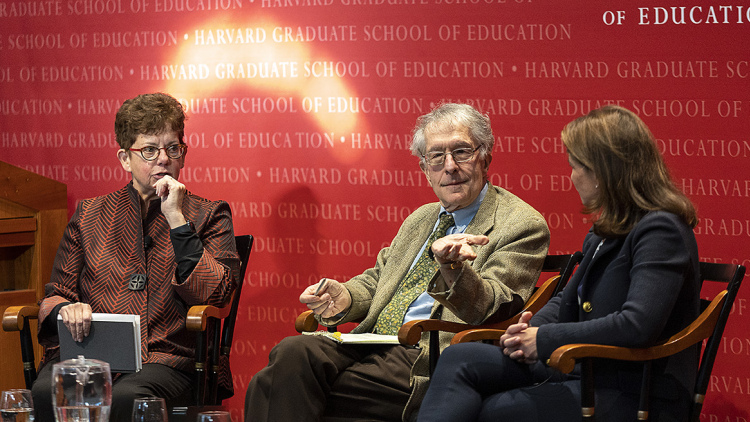
The Real World of College

The Questionable Ethics of College Students

Advice to an Aspiring Researcher

Bullying Prevention and Mental Health Promotion Lab
The Bullying Prevention and Mental Health Promotion Lab conducts research on topics including bullying and bullying prevention, school-based mental health services and prevention of mental health problems, mental health literacy, help-seeking among culturally and linguistically diverse (CLD) students, parenting practices and family involvement.
Some of our recent projects include:
- Influences of the Coronavirus (COVID-19) Outbreak on Racial Discrimination, Identity Development and Socialization (funded by NSF)
- Racial Discrimination, Identity, Socialization and Civic Engagement among Asian American Families during COVID-19 (funded by Russell Sage Foundation)
- Examining the Feasibility and Effectiveness of a Novel Psychosocial Intervention for Asian American Parents and Youth during COVID-19 (funded by American Psychological Foundation 2020 Visionary Grant)
- Promoting mental health literacy and positive help-seeking attitudes for school-based mental health services among minority adolescents
- The impact of school (e.g., school climate) and family factors (e.g., parenting practice, parental ethnic racial socialization) on students’ involvement in bullying and psychosocial adjustment
If you are a prospective student interested in applying to Dr. Wang's lab, please send an e-mail expressing your interest to [email protected] . You may also email the lab manager, Ami Patel, with any questions at [email protected] . Applicants with an interest in school-based mental health services, peer relationships, bullying prevention, parenting practice, working with culturally and linguistically diverse (CLD) students, and bridging the gap between research and practice are especially encouraged to apply.
Digital media in informal learning activities
- Published: 03 May 2024
Cite this article

- Gulsara Tazhenova 1 ,
- Natalia Mikhaylova 2 &
- Botagul Turgunbayeva 1
42 Accesses
Explore all metrics
This study aims to investigate digital media in the context of informal educational activities to determine their impact on learning effectiveness and the level of participant engagement. It was assumed that the integration of digital media into informal education positively influences the effectiveness of learning, the level of student engagement, and their motivation toward educational activities. An experimental approach was employed in this research to assess the influence of digital media on participant engagement in informal educational activities, utilizing survey methods. The study was conducted with the participation of representatives from the Ural Federal University named after the first President of the Russian Federation, B. N. Yeltsin, and Al-Farabi Kazakh National University. The study compared the effectiveness of informal educational activities with and without the use of media technologies in terms of participant engagement. In summary, the use of digital media in informal educational activities has a positive impact on the behavioural and emotional completeness of participants, while cognitive completeness did not show statistically significant differences between the groups. The results of this study have practical significance for educational institutions and educators involved in organizing informal educational activities. It provides insights into how the integration of digital media into the learning process can influence participant engagement. It’s important to remember that the research sample had a specific geographic coverage, so generalizing the obtained results should be exercised with prudence. This study has significant practical implications for educators and institutions involved in organizing non-formal educational activities. Educators can use the acquired information to create more diverse learning environments that promote student engagement. Additionally, they can develop and implement new teaching methods that maximize the use of digital technologies and create stimulating and captivating lessons, fostering a more active student involvement in learning. Teachers can optimize their pedagogical approach by adapting and integrating new means of interaction with students, contributing to their deeper understanding and active participation in the learning process.
This is a preview of subscription content, log in via an institution to check access.
Access this article
Price includes VAT (Russian Federation)
Instant access to the full article PDF.
Rent this article via DeepDyve
Institutional subscriptions
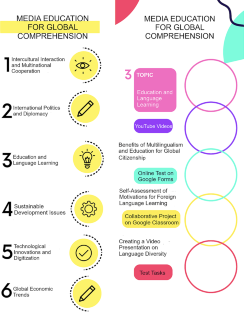
Similar content being viewed by others

Students’ voices on generative AI: perceptions, benefits, and challenges in higher education

Exploring the role of social media in collaborative learning the new domain of learning

Social Media and Higher Education: A Literature Review
Data availability.
Data will be available on request.
Abdallah, A., & Alkhrabsheh, A. (2019). The best leadership styles for preventing the educational crisis. Opción: Revista De Ciencias Humanas Y Sociales , 20 , 90–105.
Google Scholar
Ali, P. A., & Naylor, P. B. (2010). Association between academic and non-academic variables and academic success of diploma nursing students in Pakistan. Nurse Education Today , 30 (2), 157–162. https://doi.org/10.1016/j.nedt.2009.07.006
Article Google Scholar
Ang, S. S., Orozco, M., Gijbels, D., & Van den Bossche, P. (2018). Learning in the context of work in a digital age: The use of digital media in informal and formal learning contexts. In C. Harteis (Ed.), The Impact of Digitalization in the Workplace (pp. 87–101). Springer. https://doi.org/10.1007/978-3-319-63257-5_7
Bakar, M. A., Mukhtar, M., & Khalid, F. (2019). The development of a visual output approach for programming via the application of cognitive load theory and constructivism. International Journal of Advanced Computer Science and Applications , 10 (11), 1. https://doi.org/10.14569/ijacsa.2019.0101142
Baker, F. (2014). Reflections on an informal learning environment with invocations for classroom learning in Dubai, the United Arab Emirates. International Journal of Adolescence and Youth , 19 (1), 50–66. https://doi.org/10.1080/02673843.2012.699880
Bangun, C. S., Purnama, S., & Panjaitan, A. S. (2022). Analysis of new business opportunities from online informal education mediamorphosis through digital platforms. International Transactions on Education Technology , 1 (1), 42–52. https://doi.org/10.33050/itee.v1i1.184
Bleakley, A., Bligh, J., & Browne, J. (2011). Socio-cultural learning theories. In A. Bleakley, J. Bligh, J. Browne (Eds.), Medical education for the future: Identity, power and Location (pp. 43–60). Springer. https://doi.org/10.1007/978-90-481-9692-0_4
Carliner, S. (2023). Informal learning basics . American Society for Training and Development.
Chang, C. T., Tu, C. S., & Hajiyev, J. (2019). Integrating academic type of social media activity with perceived academic performance: A role of task-related and nontask-related compulsive internet use. Computers & Education , 139 , 157–172. https://doi.org/10.1016/j.compedu.2019.05.011
Cukurova, M., Giannakos, M., & Martinez-Maldonado, R. (2020). The promise and challenges of multimodal learning analytics. British Journal of Educational Technology , 51 (5), 1441–1449. https://doi.org/10.1111/bjet.13015
Doebel, S. (2020). Rethinking executive function and its development. Perspectives on Psychological Science , 15 (4), 942–956. https://doi.org/10.1177/1745691620904771
Doleck, T., Lajoie, S. P., & Bazelais, P. (2019). Social networking and academic performance: A net benefits perspective. Education and Information Technologies , 24 (5), 3053–3073. https://doi.org/10.1007/s10639-019-09913-3
Dung, D. T. H. (2020). The advantages and disadvantages of virtual learning. IOSR Journal of Research & Method in Education , 10 (3), 45–48. https://doi.org/10.9790/7388-1003054548
Falloon, G. (2020). From digital literacy to digital competence: The teacher digital competency (TDC) framework. Educational Technology Research & Development , 68 (5), 2449–2472. https://doi.org/10.1007/s11423-020-09767-4
Farrokhnia, M., Pijeira-Díaz, H. J., Noroozi, O., & Hatami, J. (2019). Computer-supported collaborative concept mapping: The effects of different instructional designs on conceptual understanding and knowledge co-construction. Computers & Education , 142 , 103640. https://doi.org/10.1016/j.compedu.2019.103640
Giannakos, M., & Cukurova, M. (2023). The role of learning theory in multimodal learning analytics. British Journal of Educational Technology , 54 (5), 1246–1267. https://doi.org/10.1111/bjet.13320
Han, S., & Yi, Y. J. (2019). How does the smartphone usage of college students affect academic performance? Journal of Computer Assisted Learning , 35 (1), 13–22. https://doi.org/10.1111/jcal.12306
Hassanzadeh, M., Hatami, J., Latifi, S., Farrokhnia, M. R., & Saheb, T. (2016). Teaching science for understanding: The positive impact of simultaneous use of concept mapping and computer simulations. In A. Cañas, P. Reiska, & J. Novak (Eds.), Innovating with Concept Mapping: 7th International Conference on Concept Mapping, CMC 2016, Tallinn, Estonia, September 5–9, 2016, Proceedings 7 (pp. 192–202). Springer. https://doi.org/10.1007/978-3-319-45501-3_15
He, T., & Li, S. (2019). A comparative study of digital informal learning: The effects of digital competence and technology expectancy. British Journal of Educational Technology , 50 (4), 1744–1758. https://doi.org/10.1111/bjet.12778
Article MathSciNet Google Scholar
He, T., Zhu, C., & Questier, F. (2018). Predicting digital informal learning: An empirical study among Chinese university students. Asia Pacific Education Review , 19 (1), 79–90. https://doi.org/10.1007/s12564-018-9517-x
Heidari, E., Salimi, G., & Mehrvarz, M. (2023). The influence of online social networks and online social capital on constructing a new graduate students’ professional identity. Interactive Learning Environments , 31 (1), 214–231. https://doi.org/10.1080/10494820.2020.1769682
Helsper, E. J., van Deursen, A. J. A. M., Eynon, R., & van Deursen, A. J. A. M. (2015). Tangible outcomes of internet use: From digital skills to tangible outcomes project report Retrieved September 12, 2023 from www.oii.ox.ac.uk/research/projects/?id=112
Hubbard, P. (2019). Leveraging technology to integrate informal language learning within classroom settings. In M. Dressman, & R. W. Sadler (Eds.), The handbook of Informal Language Learning (pp. 405–419). John Wiley & Sons Ltd. https://doi.org/10.1002/9781119472384.ch27
Jin, B., Kim, J., & Baumgartner, L. M. (2019). Informal learning of older adults in using mobile devices: A review of the literature. Adult Education Quarterly , 69 (2), 120–141. https://doi.org/10.1177/0741713619834726
Jurkovič, V. (2019). Online informal learning of English through smartphones in Slovenia. System , 80 , 27–37. https://doi.org/10.1016/j.system.2018.10.007
Karpenko, O. M., Lukyanova, A. V., Bugai, V. V., & Shchedrova, I. A. (2019). Individualization of learning: An investigation on educational technologies. Journal of History Culture and Art Research , 8 (3), 81–90. https://doi.org/10.7596/taksad.v8i3.2243
Kim, H., Hong, A., & Song, H. D. (2018). The relationships of family, perceived digital competence and attitude, and learning agility in sustainable student engagement in higher education. Sustainability , 10 (12), 4635. https://doi.org/10.3390/su10124635
Kress, G. (2009). Assessment in the perspective of a social semiotic theory of multimodal teaching and learning. In C. Wyatt-Smith, J. J. Cumming (Eds.), Educational assessment in the 21st century: Connecting theory and practice (pp. 19–41). Springer. https://doi.org/10.1007/978-1-4020-9964-9_2
Mangiri, H. S., Sofyan, H., Susanto, A., & Rohmantoro, D. (2019). The contribution of teacher’s digital competency to teacher’s professionalism at vocational high school. International Journal of Innovative Technology and Exploring Engineering , 9 (1), 1728–1731. https://doi.org/10.35940/ijitee.A5198.119119
Mehrvarz, M., Heidari, E., Farrokhnia, M., & Noroozi, O. (2021). The mediating role of digital informal learning in the relationship between students’ digital competence and their academic performance. Computers & Education , 167 , 104184. https://doi.org/10.1016/j.compedu.2021.104184
Mishra, S. (2020). Social networks, social capital, social support and academic success in higher education: A systematic review with a special focus on underrepresented students. Educational Research Review , 29 , 100307. https://doi.org/10.1016/j.edurev.2019.100307
Mohammed, S. H., & Kinyó, L. (2020). The role of constructivism in the enhancement of social studies education. Journal of Critical Reviews , 7 (7), 249–256. https://doi.org/10.31838/jcr.07.05.01
Nyikes, Z. (2018). Contemporary digital competency review. Interdisciplinary Description of Complex Systems , 16 (1), 124–131. https://doi.org/10.7906/indecs.16.1.9
Peters, M., & Romero, M. (2019). Lifelong learning ecologies in online higher education: Students’ engagement in the continuum between formal and informal learning. British Journal of Educational Technology , 50 (4), 1729–1743. https://doi.org/10.1111/bjet.12803
Rahmatirad, M. (2020). A review of socio-cultural theory. Siasat , 5 (3), 23–31. https://doi.org/10.33258/siasat.v4i3.66
Reinders, H., & Benson, P. (2017). Research agenda: Language learning beyond the classroom. Language Teaching , 50 (4), 561–578. https://doi.org/10.1017/S0261444817000192
Sackey, D. J., Nguyen, M. T., & Grabill, J. T. (2015). Constructing learning spaces: What we can learn from studies of informal learning online. Computers and Composition , 35 , 112–124. https://doi.org/10.1016/j.compcom.2015.01.004
Xu, F. (2019). Towards a rational constructivist theory of cognitive development. Psychological Review , 126 (6), 841–864. https://doi.org/10.1037/rev0000153
Yang, Z. (2020). A study on self-efficacy and its role in mobile-assisted language learning. Theory and Practice in Language Studies , 10 (4), 439–444. https://doi.org/10.17507/tpls.1004.13
Yazon, A. D., Ang-Manaig, K., Buama, C. A. C., & Tesoro, J. F. B. (2019). Digital literacy, digital competence and research productivity of educators. Universal Journal of Educational Research , 7 (8), 1734–1743. https://doi.org/10.13189/ujer.2019.070812
Download references
Acknowledgements
Natalia Mikhaylova has been supported by the RUDN University Strategic Academic Leadership Program.
This research did not receive any specific grant from funding agencies in the public, commercial, or not-for-profit sectors.
Contributions
GT, NM, and BT contributed equally to the experimentation. GT, BT wrote and edited the article. BT and NM equally designed and conducted the experiment. GT, NM studied scientific literature about the topic. All authors read and approved the final manuscript.
Corresponding author
Correspondence to Gulsara Tazhenova .
Consent to participate
Informed consent was signed by participants.
Competing interests
The authors report there are no competing interests to declare.
Additional information
Publisher’s note.
Springer Nature remains neutral with regard to jurisdictional claims in published maps and institutional affiliations.
Rights and permissions
Springer Nature or its licensor (e.g. a society or other partner) holds exclusive rights to this article under a publishing agreement with the author(s) or other rightsholder(s); author self-archiving of the accepted manuscript version of this article is solely governed by the terms of such publishing agreement and applicable law.
Reprints and permissions
About this article
Tazhenova, G., Mikhaylova, N. & Turgunbayeva, B. Digital media in informal learning activities. Educ Inf Technol (2024). https://doi.org/10.1007/s10639-024-12687-y
Download citation
Received : 12 September 2023
Accepted : 10 April 2024
Published : 03 May 2024
DOI : https://doi.org/10.1007/s10639-024-12687-y
Share this article
Anyone you share the following link with will be able to read this content:
Sorry, a shareable link is not currently available for this article.
Provided by the Springer Nature SharedIt content-sharing initiative
- Educational activities
- Informal education
- Interactive tools
- Pedagogical practice
- Technology-enhanced learning
- Find a journal
- Publish with us
- Track your research

- Latest News
- Year of Sustainability
- Abu Dhabi in a Week
- Arts & Culture
- Crown Prince
- Environment
- Government Affairs
- Infrastructure
- Initiatives
Abu Dhabi Media Office - Copyright 2024
Popular search terms
- Mohamed bin Zayed
- Khaled bin Mohamed bin Zayed
- Emirates College for Advanced Education concludes 10th Annual Autism Day event
10 May 2024
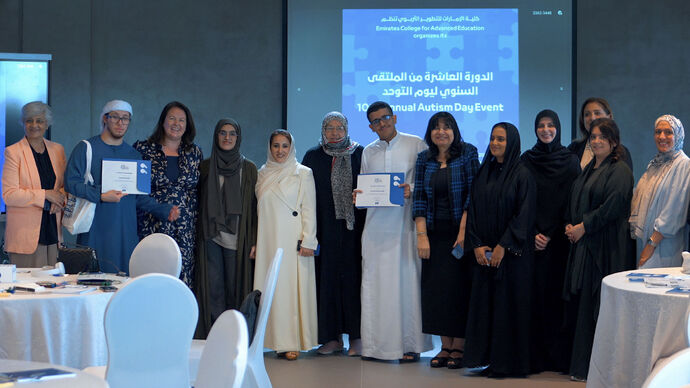
Share this article
- Link Copied
The Emirates College for Advanced Education (ECAE) has concluded its 10th Annual Autism Day event, which was aligned with Autism Awareness Month. The event aimed to raise social awareness among students living with autism, and highlight future learning opportunities and best practices for educators.
Since 2014, the annual event aims to reflect ECAE’s mission to involve the UAE community in fostering a more inclusive and supportive education sector, by focusing on elevating social awareness among students with autism spectrum disorder (ASD), while spotlighting future learning opportunities and best practices for educators in the UAE and beyond.
Dr May AlTaee, Vice Chancellor at ECAE, said: “Our Autism Day event is a beacon of hope and progress in the realm of inclusive education. It reflects our deep-rooted belief that understanding and embracing diversity strengthens the fabric of our educational community. As the ECAE continues to champion inclusivity, it remains committed to ensuring that the educational system evolves to meet the diverse needs of its learners.”
The conference featured a series of enriching sessions aimed at addressing various aspects of inclusion and education for students with ASD. The conference included an exploration into the daily life of an inclusion expert, shedding light on the importance of the work of these educators in the lives of students of determination. The event also highlighted a research surrounding inclusion challenges in kindergarten and Cycle 1 education, providing attendees with evidence-based insights into overcoming challenges.
An exemplary model of inclusive practices implemented in a school setting was shared offering a blueprint for replication across educational institutions. The importance of learning support assistant training was also underscored, highlighting its role in supporting students with autism. The conference concluded with sessions by a teacher and students with ASD, sharing their experiences and perspectives on inclusion.
The discussions aimed to enrich the knowledge of participants and foster a collaborative atmosphere for sharing best practices and innovative solutions. The event aimed to underscore ECAE’s role in leading the charge towards an educational future where all students are supported.

Emirates College for Advanced Education partners with Emirates Red Crescent to organise Charity Collection initiative

Emirates College for Advanced Education launches diverse education initiatives for UAE Innovation Month
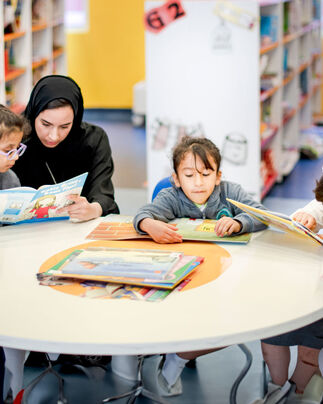
Emirates College for Advanced Education launches calendar of events for Reading Month 2024

Khaled bin Mohamed bin Zayed attends Education First Forum
Related stories.

2nd Abu Dhabi Government Games concludes in Abu Dhabi
- Terms & Conditions
- Privacy Policy

COMMENTS
Today's students and educators have adopted social media for various purposes both within education and outside of it. This review of the published research on social media in education focuses on the affordances for student learning, teacher professional development, educational research practices, and communication of scholarship.
The use of social media in higher education has been demonstrated in a number of studies to be an attractive and contemporary method of teaching and learning. However, further research and investigation are required in order to align social media's pedagogical benefits with the theoretical perspectives that inform educational practices. It is the objective of this study to provide a systematic ...
1. Introduction. The importance of social media for today's youth often elicits teachers to explore the added value of educational use of these media (e.g. Bate, Citation 2010).However, many teachers experience social media in classrooms as disturbing (Selwyn, Citation 2010).Teachers appear to struggle with the tension between possible pedagogical use and the tempting distraction of this ...
14. Iterate social strategy to create student-centric content. Using social media for education allows educators and marketers to meet students where they are by connecting on channels they use everyday. Social creates an opportunity for institutions to be more even more student-centric.
Using Instagram in an Educational Context: The EmergingEdTech blog is a wonderful source for tips, strategies, and ideas for using social media and other new technologies in the classroom. This guide is a great primer for understanding what Instagram is and how it can be used to teach and reach students. " 5 Ways Teachers Can Use Instagram in ...
7. Create opportunities for active and passive learning. 8. Teach networking and thought leadership skills. 9. Develop discussion and critical thinking skills. 10. Celebrate student and alumni achievements. Social media has revolutionized the way we connect and communicate with each other.
Best Practices for Social Media in Education. For many young people, social media is a part of their (and their parents') everyday lives. Chances are, if a teacher chooses to incorporate social media into a lesson, many students will already be familiar with the platform and how to use it. Since students may be accustomed to using social ...
Tips from Social Media for Educators: Strategies and Best Practices. 8 Things You Should Know Before Using Social Media in Your Course. Learning in Bursts: Microlearning with Social Media ... Overcoming Hurdles to Social Media in Education. Facebook 'real name' policy stirs questions around identity. Repository of Campus Policies and Other Guides
The prevalence of social media and its uses for educational purposes have been emerging in the past decade. Social media, also called "social networking sites" (SNSs) and "Web 2.0", is defined as "technologies that emphasize the social aspects of the internet as a channel for social interaction and collaboration" [].It allows users to engage and share content generated by other ...
Social media use has penetrated the world of education with an increasingly important role. Social media, such as Facebook, Twitter, Instagram, and other platforms, have become tools of communication and interaction that allow educators and students to connect outside the classroom environment (Erarslan, 2019; Patmanthara et al., 2019).Uses of social media in learning and teaching have been ...
Published: February 1, 2024. Social media creates a continuously evolving landscape that frequently overlaps with learning environments. The sharing of education-related information and connections made through social media challenge educators and their unions to identify concerns and ensure that recommendations are in place before problems arise.
Empowering Effects. Starting from elementary school up until university graduation, social media has the role to empower parents, students and teachers to use new ways of sharing information and build a community. Statistics show that 96% of the students that have internet access are using at least one social network.
Although social media has a large presence in news and entertainment, when used in the learning setting for educational purposes it has the potential to facilitate communication, augmenting the student experience and improving outcomes, by: Encouraging interaction and engagement among students. Nurturing a student-centric learning setting.
Here are some of the educational approaches and benefits of social media to improve the academic performance of students: 1. Communication And Collaboration. The biggest advantage of social media is better communication. A student can connect with anyone at any point in time via Kids Messenger or WhatsApp. They can use such platforms via their ...
If a parent is comfortable with age 14, then a daily usage limit is the next step. Increased social media use has been associated with higher levels of mental health issues, decreased academic performance, lack of exercise, and general decreased well-being. Therefore, children should be limited to 30-60 minutes a day to help avoid those issues.
Social media is now a prominent avenue for personal and professional communication, with exciting educational uses emerging in stride. The interactive nature of these networks can enhance learning environments when thoughtfully deployed. Outlined below are some of the opportunities and considerations for using social media in education. 1. 2. 3 ...
In the digital age, numerous technological tools are available to enhance educational practices. When used effectively, student engagement and mobile learning are significantly increased. "Social Media in Education: Breakthroughs in Research and Practice" contains a compendium of the latest academic material on the usage, strategies, and applications of social media in education today.
Social media is an increasingly important part of students' lives. In fact, the average teen spends nearly an hour and a half a day using social media. Unfortunately, the same study reveals that tweens and teens spend on average just 7 to 12 minutes per day on creative activities. To be true digital citizens, our students need teachers who ...
Opportunities. 1. Enhanced Communication and Collaboration: Social media provides a platform for enhanced communication and collaboration between students, teachers, and parents. It allows for ...
The past few years have witnessed an explosion in the use of 'informal' social media channels to disseminate scientific information and conduct survey-based research. 1,2 This editorial details the different social media channels used for scientific communication and suggests best practices for the scientific use of social media.
university instructors' social media use both inside and outside classes, and to gain an understanding of their motivations and experience with social media use in educational practice. Our first analyses of these data [5,23] focused on how social media use and usefulness in teaching accorded with theoretical educational
Of respondents with social media accounts, 43% reported using it for educational purposes, but there was a higher percent of those who agreed that social media could be an effective educational tool (85%) (Table 2). Facebook® (27.2%) was the most commonly used social media platform for any purpose, followed by Pinterest® (17.4%) and Instagram ...
The purpose of the study is to analyze the relation that exist between time, age and gender of the employees of higher education institutions and differences in usage pattern of social media and any relationship if exits between the perceived usefulness and productivity of employees with respect to social media platforms. Employees from reputed higher education institutions from 4 cities of ...
howard-gardner-316.pdf. Contact Information. Howard Gardner is the John H. and Elisabeth A. Hobbs Research Professor of Cognition and Education at the Harvard Graduate School of Education. He is also the head of the Steering Committee of Harvard Project Zero. Among numerous honors, Gardner received a MacArthur Prize Fellowship and a Fellowship ...
The use of these tools is so overwhelming which transformed people's way of communication. Discussions on using social media in education are getting keen. However, regardless of the popularity of social media in Hong Kong, the effectiveness of using existing social media tools to facilitate teaching and learning is not noticeable.
The impact of school (e.g., school climate) and family factors (e.g., parenting practice, parental ethnic racial socialization) on students' involvement in bullying and psychosocial adjustment If you are a prospective student interested in applying to Dr. Wang's lab, please send an e-mail expressing your interest to [email protected] .
It could even be a checklist to reference when working on a case. Contact us for more details before submitting an article. GPSolo eReport is a member benefit of the ABA Solo, Small Firm and General Practice Division. It is a monthly electronic newsletter that includes valuable practice tips, news, technology trends, and featured articles on ...
The existence of digital and online technologies has contributed to social disruptions (Bangun et al., 2022).It has also altered the dynamics of the education industry, allowing it to influence the growth of digitalization, which was a pivotal moment in the Industrial Revolution (Bangun et al., 2022; He & Li, 2019).As today's educational materials are relatively accessible through on-demand ...
The Emirates College for Advanced Education (ECAE) has concluded its 10th Annual Autism Day event, which was aligned with Autism Awareness Month. The event aimed to raise social awareness among students living with autism, and highlight future learning opportunities and best practices for educators. Since 2014, the annual event aims to reflect ...